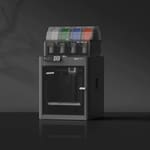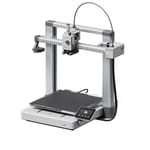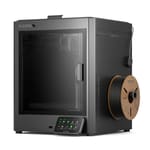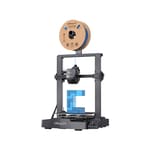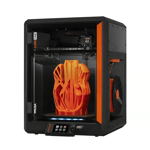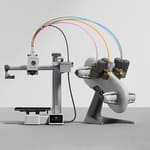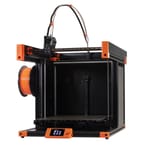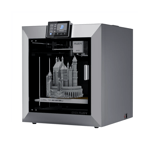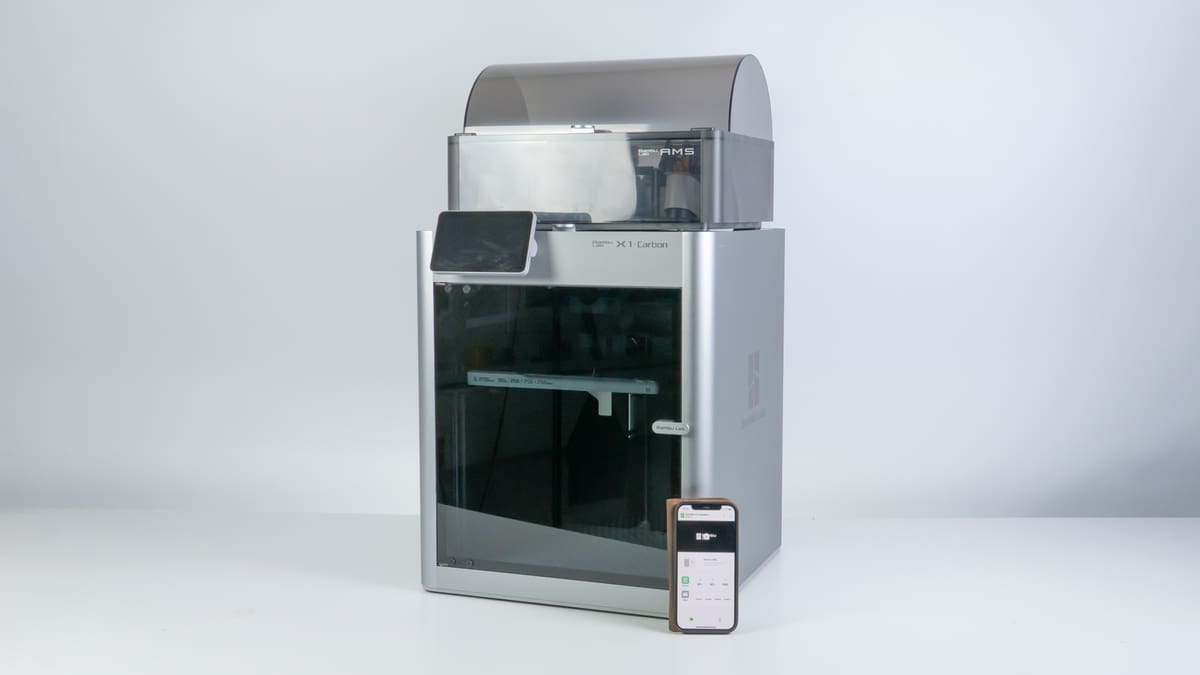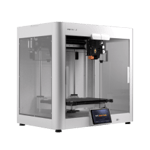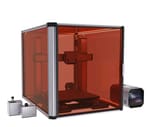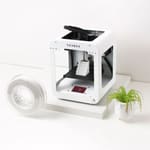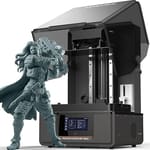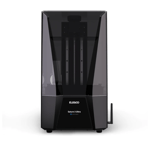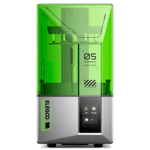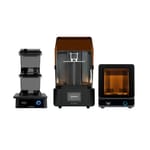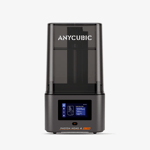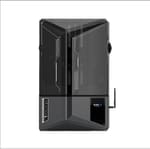It’s never been easier to get into 3D printing, with machines of all shapes, sizes, and price points making it such that there is something for everyone.
For less than $200, you can pick up a competent and compact machine that’ll easily bring your ideas to life. Likewise, tabletop gamers have it made with high-resolution resin printers capable of making insanely detailed miniatures in minutes. Makers pushed for space can tackle 3D printing, CNC, and laser engraving with just a single machine, and those needing a big printer for larger-than-life projects… you get the idea.
Uncountable avenues exist in 3D printing, and we’ve researched and tested a lot of machines to find you the best 3D printer for specific budgets and needs that you can buy right now.
| Best 3D Printer | Market Price (Approx., USD) | Check Price (Commissions earned) | |
|---|---|---|---|
| Under $1,000 (Filament): Bambu Lab P1S | Fast, connected, and enclosed with robust support and multi-material possibilities | $629 | |
| Under $500 (Filament): Bambu Lab A1 | Quick, quiet, high-quality printer with fast swappable nozzles and multicolor potential | $339 | |
| Under $300 (Filament): Elegoo Centauri Carbon | Fast-heating and surprisingly premium compact CoreXY printer | $299 | |
| Under $200 (Filament): Creality Ender 3 V3 SE | Quiet and capable low-cost all-rounder | $179 | |
| Enclosed: Prusa Core One | Studio-friendly 3D printer that can remain closed, no matter the material | $999 | |
| Beginners: Bambu Lab A1 Mini | Small, smart, speedy printer that's ideal for beginners | $219 | |
| Large-Format: Original Prusa XL | Large-volume multi-tool 3D printer that scales with your printing | $1,999 | |
| Mid-Size: Qidi Tech Plus 4 | Fast, enclosed, Klipper 3D printer with active chamber heating | $799 | |
| Small: Bambu Lab A1 Mini | Smart, capable, compact 3D printer with plenty of flexibility | $219 | |
| Premium (Filament): Bambu Lab X1C | Speed, usability, and next-gen smarts | $1,149 | |
| Budget Multicolor: Bambu Lab A1 Mini + AMS Lite | A compact and connected four-color combo | $349 | |
| Multicolor: Bambu Lab P1S + AMS | Four+ colors & fully enclosed for capable, convenient 3D printing | $849 | |
| Dependent Dual Extrusion: UltiMaker S5 | Expandable, pro-grade dual extrusion printing with solid software | $6,950 | |
| IDEX: Snapmaker J1s | Compact, heavy-duty dual extrusion printer with productivity-boosting print modes | $999 | |
| Toolchanger: Original Prusa XL | Scalable multi-material 3D printing with a large print volume | $2,499 | |
| 3-in-1: Snapmaker Artisan | Stylish desktop machine built for multi-material making | $2,999 | |
| Toy: Toybox | Cute, child-proof and a vast curated library of printable toys | $299 | |
| Under $1,000 (Resin): Anycubic Photon Mono M7 Max | Large-format resin printing with print success smarts | $849 | |
| Under $500 (Resin): Elegoo Saturn 4 16K | Fast and smart resin 3D printing at the cutting edge | $499 | |
| Under $300 (Resin): Elegoo Saturn 3 Ultra | Yesterday's mid-size flagship is today's bargain | $299 | |
| Under $200 (Resin): Elegoo Mars 5 | Simple, some-frills workhorse for 2025 | $179 | |
| Ecosystem (Resin): HeyGears Ultracraft Reflex RS Combo | Professional-style simplicity with a consumer price tag | $2,107 | |
| Small (Resin): Anycubic Photo Mono 4 Ultra | Compact, ultra-convenient resin printer with smarts | $259 | |
| Mid-Size (Resin): Elegoo Saturn 4 Ultra | Speed and print success smarts on top of a generous build volume | $399 | |
| Large-Format (Resin): Anycubic Photon Mono M7 Max | Uncompromising features and performance for a large print volume printer | $849 | |
| Beginners (Resin): Elegoo Mars 5 | Simplicity and reliability with a low stakes price tag | $249 | |
Best 3D Printers 2025
Here are our recommendations for the best 3D printer of a variety of classes, categories, and features.
Under $1,000 (Filament):
Bambu Lab P1S
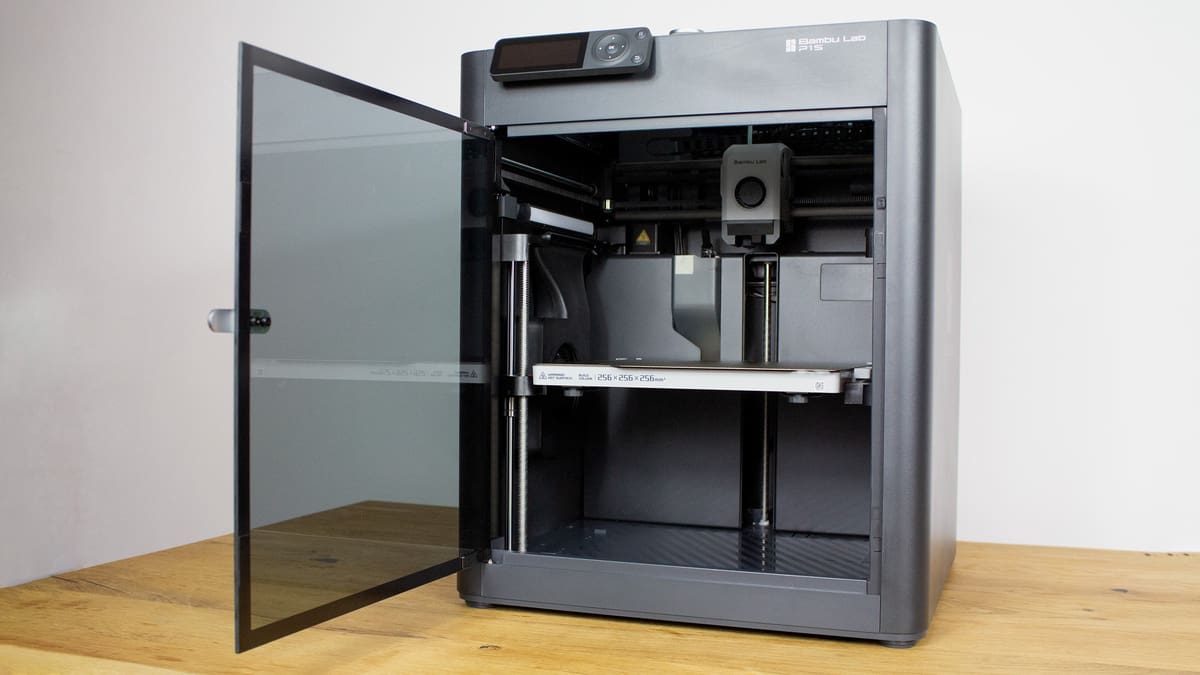
What’s Great
- Enclosed volume with temperature regulation
- Fast, high-quality printing & effective cooling
- AMS compatible
Even if the Elegoo Centauri Carbon gives it stiff competition at $300, the Bambu Lab P1S still offers plenty of reasons to spend a little more.
Building on the success of its budget P1P offering, Bambu Lab’s P1S is arguably the company’s best-value printer, giving you a fully enclosed 256 x 256 x 256 mm build volume, super quick print speeds, an auxiliary cooling fan to maintain stability printing PLA at speed, air filtration unit, plus out-of-the-box compatibility with Bambu Lab’s excellent AMS multicolor material station, for just $629.
For beginners, it’s a streamlined experience that requires little effort or prior knowledge from users to achieve great results. For more experienced makers, the software allows for complex, multi-part jobs, and the hot end can be easily upgraded to tackle tougher materials in comfort and diverse print types.
You can print directly on the machine from the company’s smartphone app–no computer necessary. The whole process is, in a word, convenient. It’s the closest thing to the 3D printer as a household appliance.
Despite the recent backlash against the company from users unhappy with the Bambu Lab’s decision to evolve its network security in a particular way, we wager there’s a legion of P1S users still very happy with their purchase.
Under $500 (Filament):
Bambu Lab A1
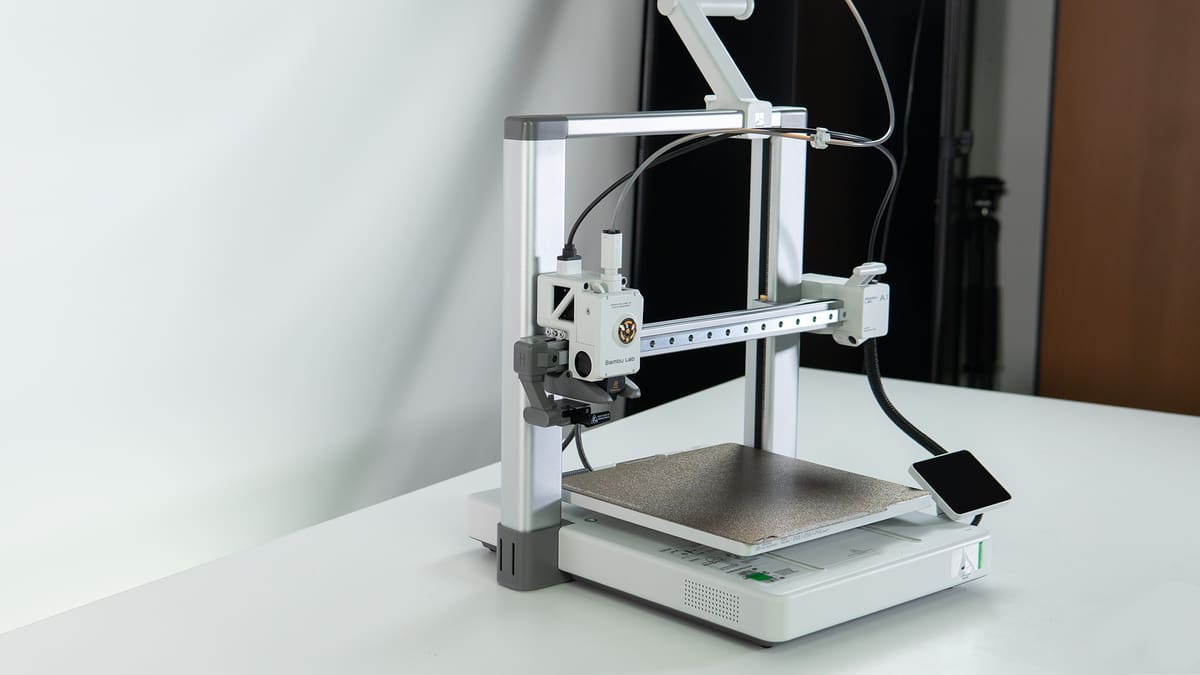
What’s Great
- Quick and quiet printing
- Fully automatic calibration and setup
- Excellent layer uniformity
There are CoreXY 3D printers that cost less and offer greater material flexibility than the A1 – *cough cough*. This is a fact. We’re sticking with our recommendation of the A1 for for budgets stretching to $500 for now, primarily because of the ease of use and ecosystem Bambu Lab provides with this machine.
The Bambu Lab A1 is a tightly tuned standard-size printer capable of dampening its movements to eliminate the motor noise of printing. The general experience is rich with the mod cons of a 3D printer, even in 2025, and includes a nicely designed removable PEI print bed that snaps into position with ease. There’s a large full-color touchscreen UI to tap away at and follow through the guided setup, and you’re never left guessing what’s happening and where you are.
The A1’s main advantage over similarly-priced systems is its toollessly swappable hot ends. Held in place by a metal cage you can open with one hand. You can drop in a variety of nozzle sizes and toughnesses (all official Bambu Lab products, priced reasonably fairly) making it effortless to scale your printing up or down, from the strength given by chunky layers to high-detail miniatures only possible with a 0.2 mm nozzle.
Lastly, there’s the possibility of adding Bambu Lab’s AMS Lite four-filament system, which enables you to use different colors and materials in the same print. It’s a ~$259 addon (or part of a discounted bundle, $559) that seriously augments the printer’s abilities and your options for printing.
Under $300 (Filament):
Elegoo Centauri Carbon
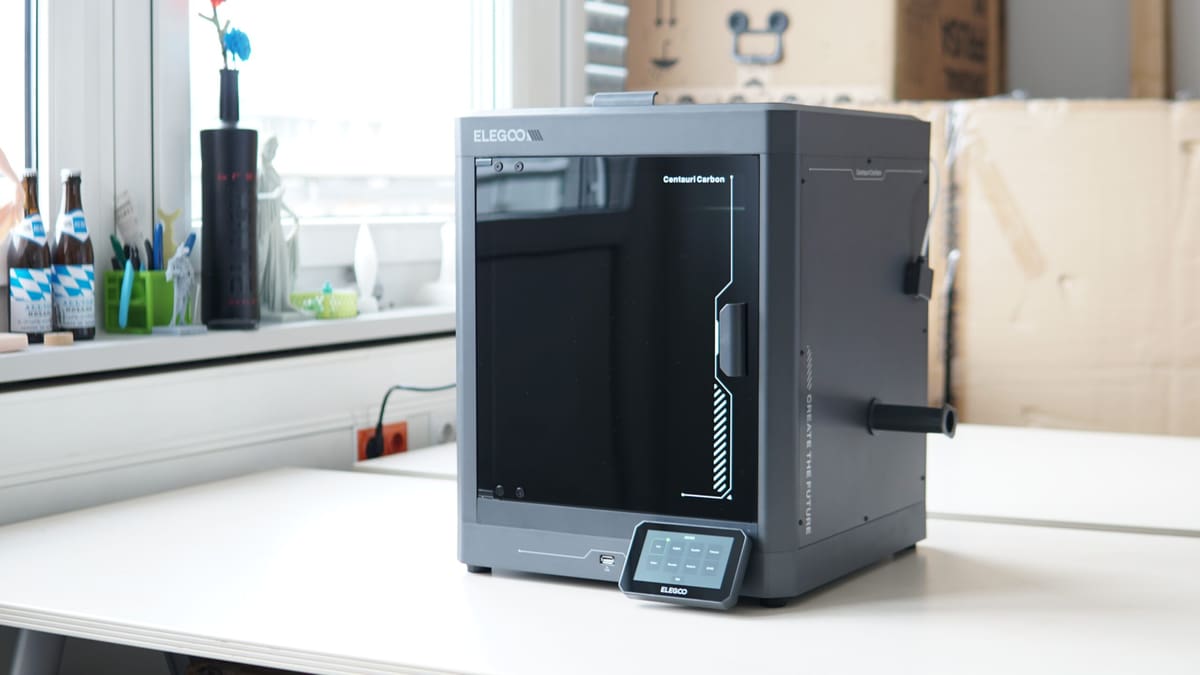
What’s Great
- Fully enclosed
- Auxilary and chamber fans for better cooling and filtration
- Fast heating bed and hot end
Elegoo’s first crack at CoreXY is a good one, with the Centauri Carbon offering staggering value for ~$300. You get robust build quality from its steel chassis, decent all-around performance, high headroom for working with difficult materials, and a fully enclosed build that includes a glass door and cover that feel too premium for the price tag.
The Centauri Carbon’s speed and specs put it on equal footing with the likes of the Creality K1C and the Anycubic S1, but it boasts one party trick those machines can’t match: a fast heating print bed. It dramatically shortens the time from hitting “print” to the machine starting to extrude, going from cold to printing temperature in less than a minute.
You get a readout of the chamber temperature, which helpfully indicates when things get too hot and opening the door is needed – yes, unfortunately, you can’t get away with leaving it fully closed off. The printer is smart enough to tell you so when things are too toasty in the chamber.
Automated calibration and the option to manually adjust the Z-offset are welcome, as is the clean UI that, honestly, seems pretty standard across brands on this class of machine.
It hasn’t presented us with 100% perfect prints every single time – few printers do – but our time with the Centauri Carbon has left us with the impression that it’s unusually good value.
Under $200 (Filament):
Creality Ender 3 V3 SE
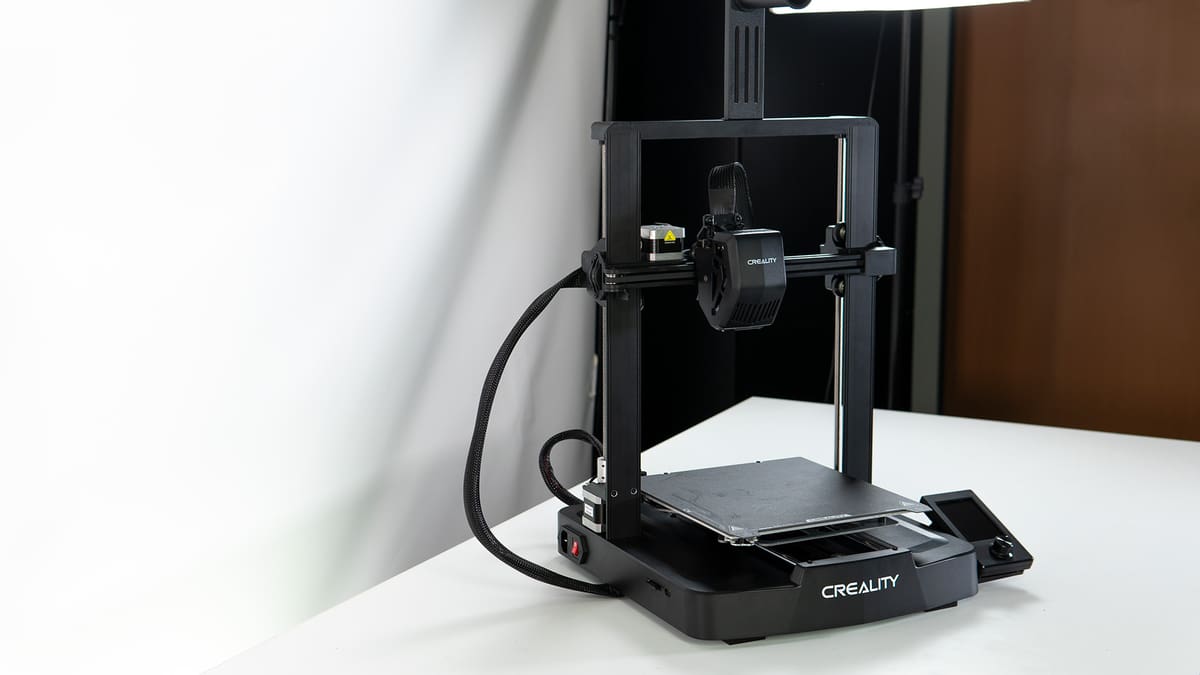
What’s Great
- Reliable auto-bed leveling system
- It’s quiet
- Great bang-for-buck ratio – cheap and capable
The Creality Ender 3 V3 SE sets a new baseline for cheap 3D printing, blending a familiar form with the beginner-friendly fully automatic bed leveling and self-offsetting to give effortlessly perfect first layers.
Its standard features run to a 220 x 220 x 250 mm build volume, with a Sprite dual-gear direct extruder feeding filament to a hot end that tops out at 260 °C. In practical terms this means your printing will be limited to lower temp materials like PLA and PETG, which are adequate for many situations. Printing through the full height is served by dual Z-axis motors, ensuring stability throughout.
In our time printing with the Ender 3 V3 SE, we’ve found it to be a little workhorse. While it lacks the flashier features and firmware flexibility of today’s pricier machines, it offers a fuss-free printing experience that’s a clear evolution of yesteryear’s Ender 3 3D printers.
The removable magnetic print bed can be a bit fussy to return to position after a print, and there’s no filament sensor, which is an odd omission these days, even at $179. All in all, a simple yet refined cheap 3D printer.
Enclosed:
Prusa Core One
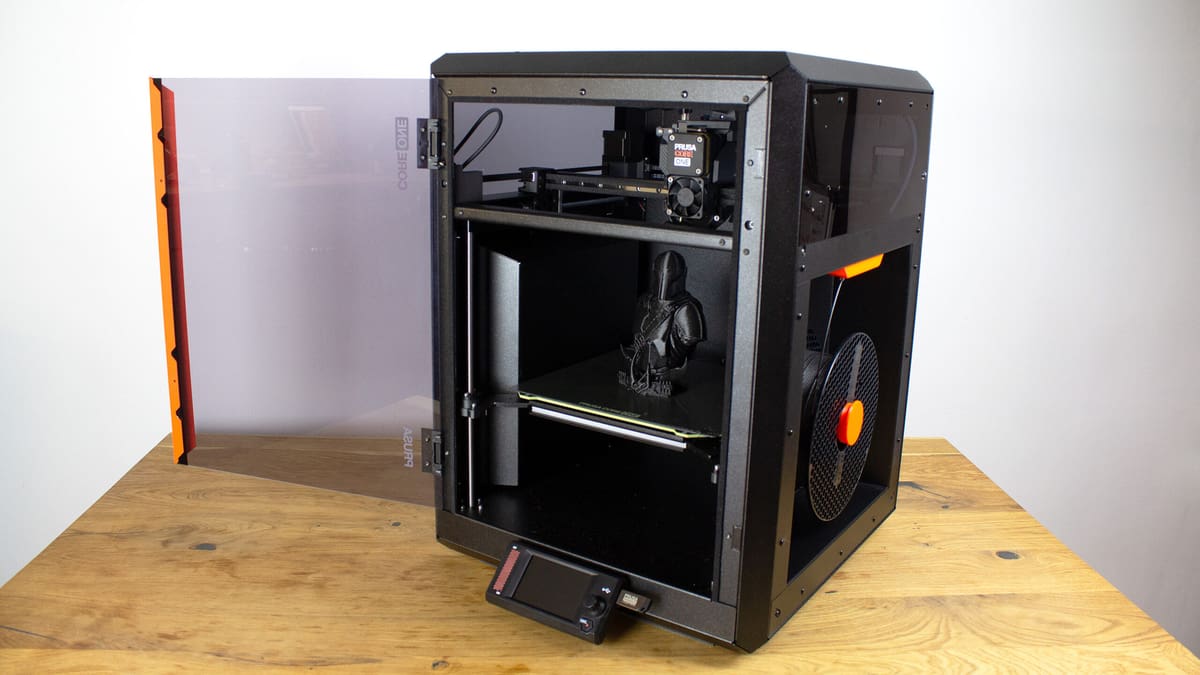
What’s Great
- Fully enclosed and can stay closed for all materials
- Massively economic with its footprint
- The most plug-and-play Prusa yet
The Prusa Core One achieves the one thing most enclosed 3D printers can’t: printing low-temperature materials with its enclosure resolutely closed. No jarred doors or propped lids, just 24/7 sealed printing, no matter the material.
It also helps the Core One’s case that it’s Prusa Research’s most complete-feeling system to date. For your $999 (if you fancy the time-honored tradition of building it yourself, otherwise it’s $1,299 for an assembled unit) you get superlative print quality, a hallmark of the brand, as well as active chamber filtration and regulation, which lets the printer moderate its the chamber’s temperature and ensure printing performance.
The build volume exceeds that of the company’s MK4 series of printers, using the same build plates (250 x 220 mm) and stretching the print height to 270 mm, all while reducing the footprint over said printers to a measly 415 x 444 x 555 mm.
It is incredibly space efficient, with recesses in the enclosure giving space for filament and accessories. The company proved at launch that the system is moddable to the extreme, with a wry Bamboo-wrapped version hogging the spotlight at 2024’s Formnext additive manufacturing show.
The Prusa Core One is the complete Prusa experience with an integrated enclosure out of the box. Arguably best of all, owners of the company’s MK4 series machines can upgrade their way to the Core One with the company’s upgrade kits, reusing many of the parts they already have in their possession.
Beginners:
Bambu Lab A1 Mini
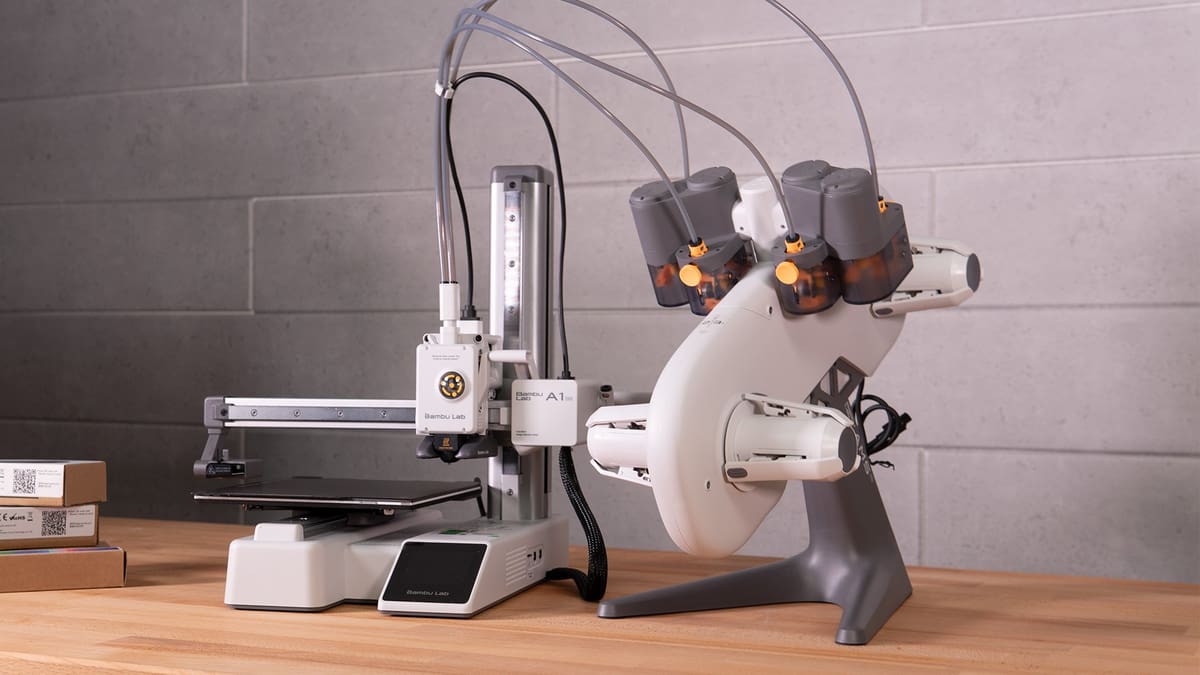
What’s Great
- Fast, with self-calibrating smarts
- High-uniformity prints
- Beginner-friendly experience
The linear rail-touting Bambu Lab A1 Mini is small, with a build volume of just 180 x 180 x 180 mm, but don’t let its size fool you into thinking it’s in any way diminished – it is packed with smarts, including noise-cancelation tech, full self-calibration, over the air updates and self-diagnostics, all for just $219. It’s also fast and, per our testing, consistently delivers impressive quality prints.
The A1 Mini offers, in a word, simplicity and builds upon this with Bambu Lab’s new MakerWorld 3D model repository, which offers one-click printing with the A1 Mini.
We found it’s not quite as polished as the company’s flagship X1C – an understandable concession, given the ~$1,000 that separates them and the difference in intended user. Largely, though, these compromises are few and far between and well worth bearing for the savings and variety of quality-of-life features that come with the machine. A high-quality camera for remote monitoring, a (admittedly finicky) nozzle wiper, and – perhaps most importantly – a hot end that allows for toolless swapping, making it trivial to change nozzle sizes for fast or highly detailed prints.
Its printing capabilities are a little narrower than other Bambu Lab printers (you’re more or less confined to PLA, PETG, and TPU-like filament), but your horizons widen somewhat with the A1 Mini’s compatibility with Bambu Lab’s AMS lite, a four-filament system for multicolor and multi-material printing.
All told the Bambu Lab A1 Mini is the ideal beginner 3D printer and a machine that we have recommended to friends who are getting into the hobby.
Large-Format:
Original Prusa XL
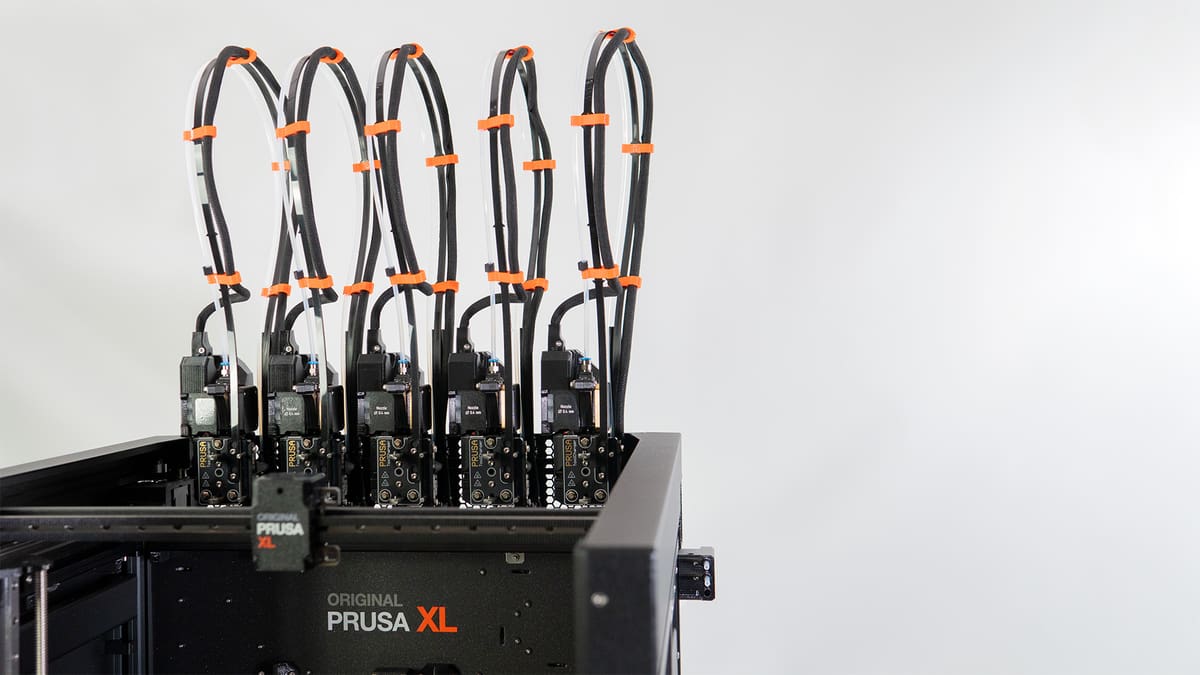
What’s Great
- Frequent updates & improvements
- Upgradability for multi-material/enclosure
- Scales with your printing
A long time coming and, for some, well worth the wait. Prusa Research’s first foray into larger-scale 3D printing comes in the form of the Original Prusa XL, a 360 x 360 x 360 mm CoreXY style 3D printer with one unique feature you won’t find on any other machine in the space: a toolchanger.
Starting at $1,999 for the base single-toolhead printer, you can configure your way up to five independent toolheads (from $3,499) each a direct drive Nextruder-toting extrusion system capable of printing virtually any desktop-grade material with minimized purging required between material swaps. You can mix and match nozzles, too, resulting in creative solutions for speeding up and adding versatility to your prints.
We’ll admit that the XL is a touch on the smaller side for what we consider “large” – it’s actually about as small as we’d go – but that 360 x 360 mm build area is more than ample for ostentatious full-size helmet prints and other oversized bits you may need to make.
Underpinning this build area is a removable high-quality satin-finish print bed. And beneath that is one of the XL’s other USPs: zonal print bed heating. The entire build area is split between 16 independent heating tiles, meaning the bed will only heat where it needs to. Note that while this sounds like a time-saving measure, it’s more about energy efficiency – having tested it, the printer will still perform a “heat soak” before each print to properly heat up and ensure first layer performance.
The XL’s versatility is its strongest suit: if you upgrade to a multi-toolhead version (Prusa sells it with 2x toolheads from $2,499 and 5x toolheads from $3,499) you gain the chance to mix flexibles, tough, abrasive, and everything in between, in your prints. In large-scale printing, being able to use cheaper filaments for support structures is a pretty radical money-saver.
Other pluses include Wi-Fi connectivity and web-based monitoring, eco-friendlier packaging, generous freebies in the box, and the high likelihood that the machine’s functionality and feature set will grow. Through the course of 2024, Prusa Research activated the XL’s touchscreen, improved speed and volume when printing, and app compatibility.
On top of all that, an optional enclosure boosts the XL’s performance with warp-happy materials and adds air filtration, for safer printing in proximity.
Mid-Size:
Qidi Tech Plus 4
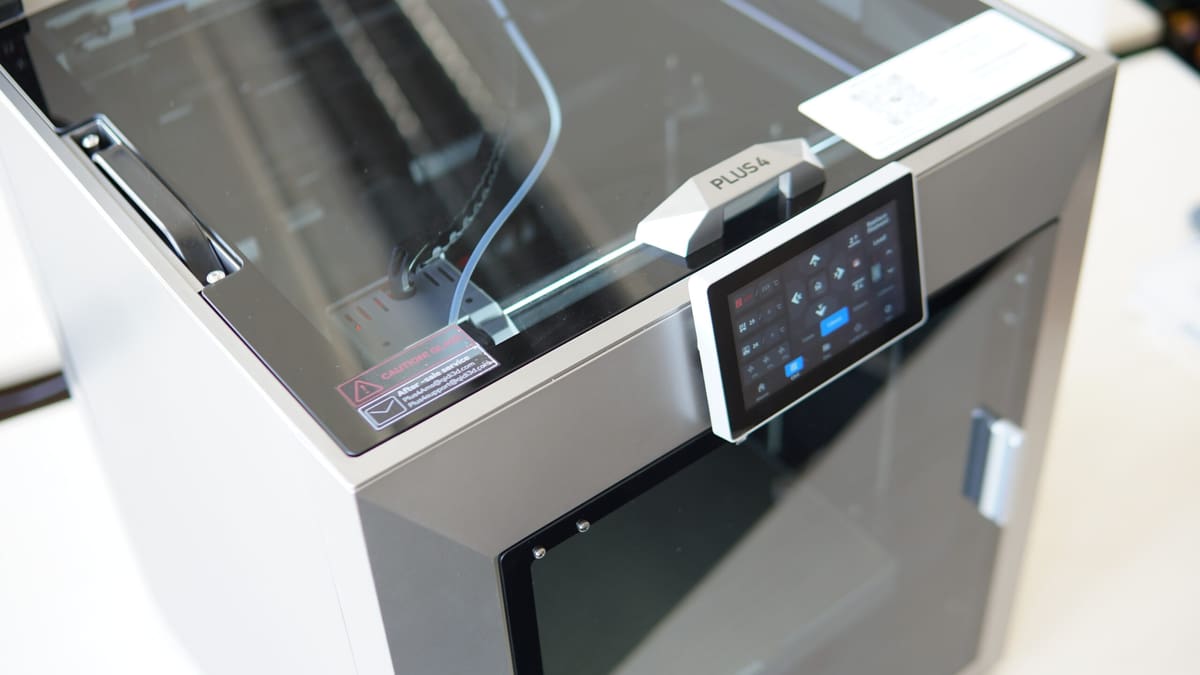
What’s Great
- Fast, high-quality printing
- User-friendly and accessible design
- High-power heated chamber
Despite an early wobble that saw Qidi Tech quickly redesign its chamber heater, the revised Plus 4 stands as an impressively complete mid-size 3D printer.
For your ~$800 you get a 305 x 305 x 280 mm fully enclosed build volume with active chamber heating, plus a hot end and heated bed that go hot enough to tackle high temp engineering materials.
You’re also getting the full Klipper experience, with a Qidi Techified UI on the large full-color display to tap and prod at for the basic printer functions.
Left at its defaults, it’s capable of high-speed printing, with Qidi Tech’s skin of OrcaSlicer being a complete enough experience for you to achieve high-quality prints right out of the box.
Thoughtful design touches like the integrated carry handles, Ethernet port for networking, plus an easily serviceable hot end make it a fine mid-size printing companion suitable for most 3D printing situations and eventualities.
Small:
Bambu Lab A1 Mini
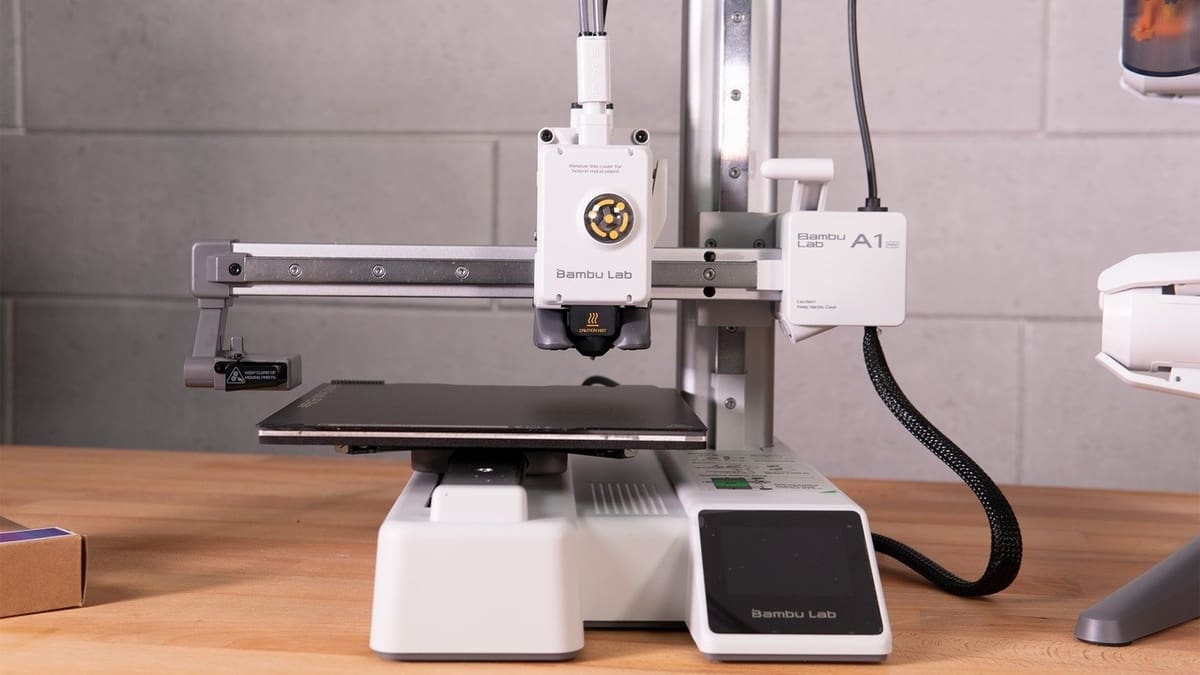
What’s Great
- Compact, self-contained footprint
- Exceptional print quality
- Self-diagnostic smarts and print improvement algorithms
Arguably Bambu Lab’s most impactful 3D printer, the A1 Mini is an uncompromising little machine. Showing its prowess through things like the motor noise cancellation calibration, which sees the printer measuring its movements, gradually canceling out the vibrations to result in whisper-quiet operation. Even today, over a year after its release, this is still an unusual feature.
You get a 180 x 180 x 180 mm build volume to work with on the A1 Mini, with its lightweight cantilever design seeing a 280°C hot end whip about the build plate as quickly as the company’s bigger, more expensive machines. Your printing is limited to everyday lower-temp materials like PLA and PETG, but this is understandable given it’s an open-frame 3D printer.
The A1 Mini’s printing capabilities can be upgraded with Bambu Lab’s AMS Lite multi-filament feeder device, although we’d argue this blows the printer’s quality as a “small” 3D printer out of the water since it doubles the footprint.
Further capability upgrades can be made using the hot ends Bambu Lab offers for its A-series machines, which are virtually drop-in once you’ve disengaged the cage that keeps them in place.
All in all, it’s a thoroughly capable, quick, and flexible 3D printer that demands very little desktop space.
Budget Multicolor:
Bambu Lab A1 Mini + AMS Lite
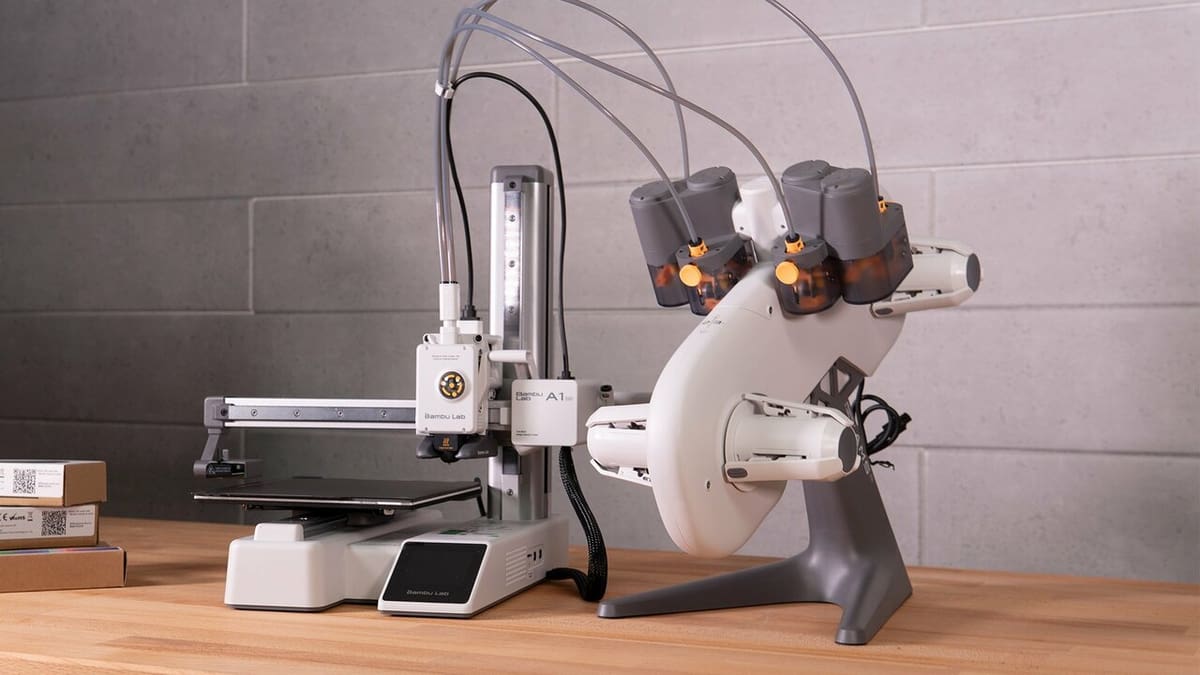
What’s Great
- Four-filament printing
- Self-calibrating smarts
- Plug-and-play
Despite its mini size and name, the Bambu Lab A1 Mini is a surprisingly complete 3D printer, giving the full, slick, connected, and productive experience offered by the rest of Bambu Lab’s more premium lineup of 3D printers, in a compact form and slim price tag ($369) to boot. For that reason, we’re drawing attention to it as a low-cost entry point to multicolor printing.
It’s a smart little cookie, with self-calibrations keeping the print quality high and the printer quiet. For multicolor printing, it uses the AMS Lite, which sits next to the printer and feeds filament through an array of guide tubes into a buffer that sits atop the print head. Powered directly by the printer, the AMS Lite is a relatively unintrusive system, though it does expand the footprint of the overall setup. You need desk space for this.
Together, the A1 Mini and AMS Lite let you combine up to four different spools of filament in a single print job, be it multiple colors of the same material, or, to a limited degree, different materials, but mind that the A1 Mini printer is only rated for lower-temp materials such as PLA, PETG, PVA, and TPU. Of those, the AMS Lite cannot feed TPU or similar soft materials.
It’s a single-nozzle system, so some material purging is required to keep color transitions clean. Historically, the printer’s default purge behavior has led to criticism of it being wasteful, which it certainly can be when printing small, colorful objects. There are measures to offset this, such as purging into an object’s infill or printing a dedicated purge object alongside your desired print.
Multicolor:
Bambu Lab P1S + AMS
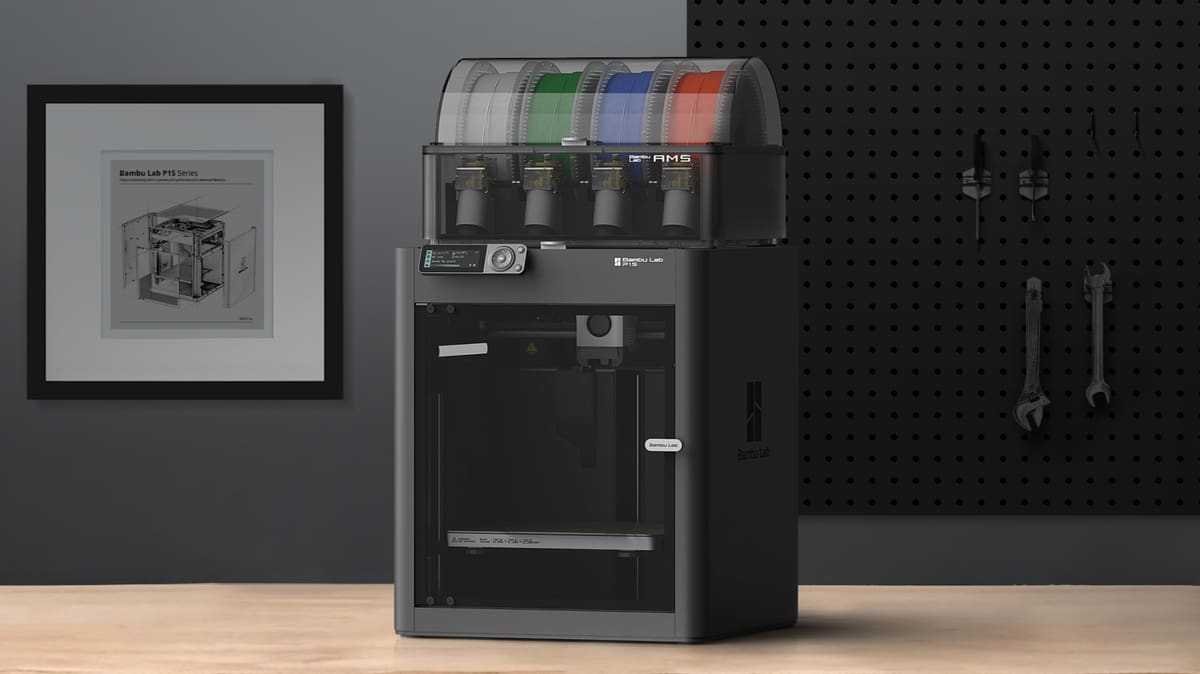
What’s Great
- Enclosed volume with temperature regulation
- Fast, high-quality printing & effective cooling
- Slick, connected software ecosystem
The Bambu Lab P1S is a comprehensively decent 3D printer for its $629 price tag. But alone, it is not a multicolor or multi-material 3D printer. Combine it with Bambu Lab’s Automatic Material System (AMS), a standalone box that houses four spools of filament, and the P1S can be supercharged to use up to four filament spools in a single print.
You get a 256 x 256 x 256 mm enclosed build volume and a print system with a direct extruder and hot end that heats to 300 °C. The AMS alone costs ~$310, but you can shave $100 off the total by buying both together for ~$830.
The base AMS lets you print with four filaments, but you can cluster four of them together for prints using 16 (that’s not a typo) filaments in total.
Handily, you don’t even need a split model for multicolor printing here – you can paint colors in the Bambu Studio slicer, configuring colorful prints on the fly from single-piece models.
As a system for printing more than one filament, its strength lies in using materials of the same type. Temperature jumps for different material types will increase the print time. Like with the A1 Mini, the default nozzle purging is excessively wasteful, but there are things you can do to minimize this.
Dependent Dual Extrusion:
UltiMaker S5
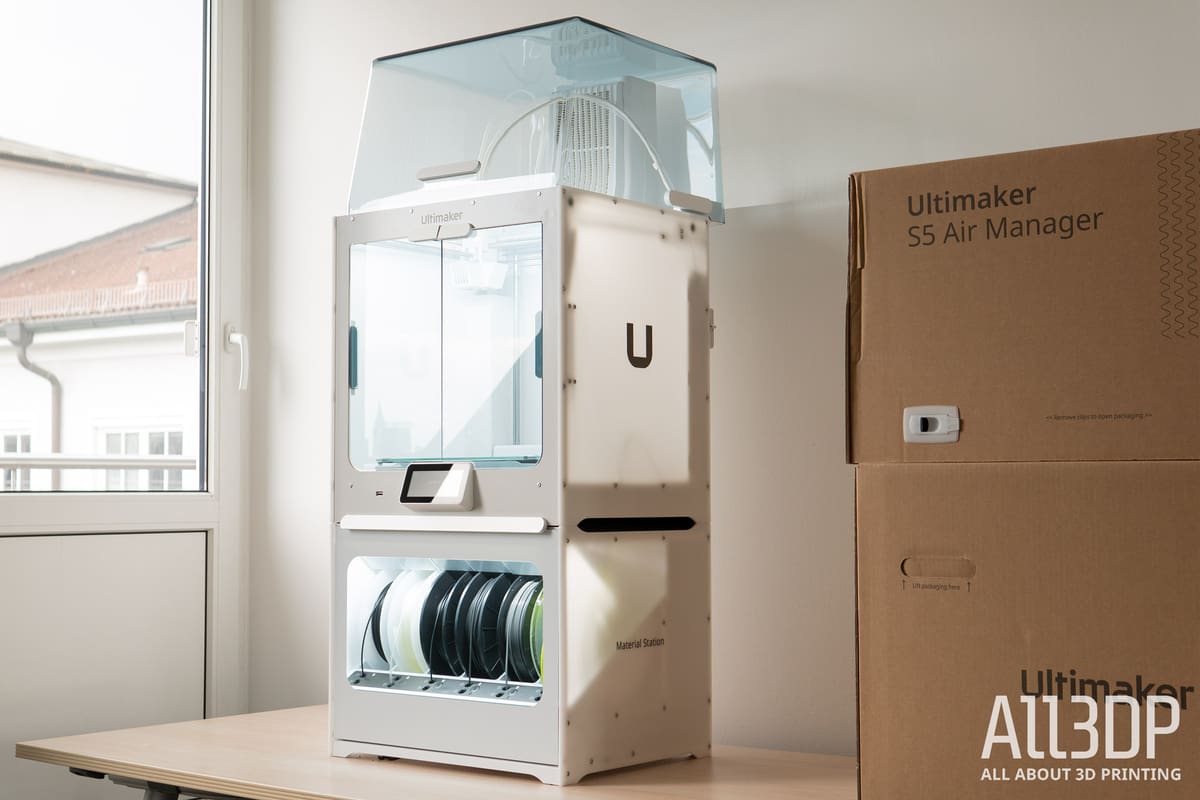
What’s Great
- Powerful printer management software
- Simplified printing experience
- Print core system simplifies nozzle changes
Dual-nozzle, or “dependent dual extrusion”, is a segment of machine that has largely been abandoned by desktop 3D printer manufacturers. We imagine this is because most consumer needs in dual-extrusion printing these days are served by multi-material style add-ons for single-nozzle 3D printers.
Pro users set on authentic dependant dual extrusion are left looking to the likes of UltiMaker and Raise3D, who straddle the line for consumer levels of ease of use with pro-grade hardware. Insofar as a simple, productive machine that gets out of the way of you printing dual material prints, the UltiMaker S5 endures as a long-term favorite of ours.
The base UltiMaker S5 3D printer costs $6,950. That’s expensive. But the tech is quite novel, achieving dual extrusion 3D printing using UltiMaker’s swappable “print cores.” These compact hot ends can be quickly swapped in and out of the printer, with each tailored to a particular material and type of printing: from a PVA soluble-support specific core to a larger-bore toughened nozzle that’s best suited to filled, abrasive polymers. Two different print cores can be combined in a job to achieve efficient print strategies.
UltiMaker’s software ecosystem begins with the free and open Cura slicing software, which has a simple UI through which you can select from a long list of materials, find more in the company’s online material library (or create your own), and progresses up the enterprise-centric UltiMaker Platform, which incorporates model management, printer management, online support, software plugins, and educational materials and certifications.
The UltiMaker S5 is all about uptime, which is its strongest proposition when augmented with the Pro bundle (add ~$4,400 to the price tag) which adds a filament loader and air filtration lid (pictured above) for office-friendly downtime-resistant 3D printing.
IDEX:
Snapmaker J1s
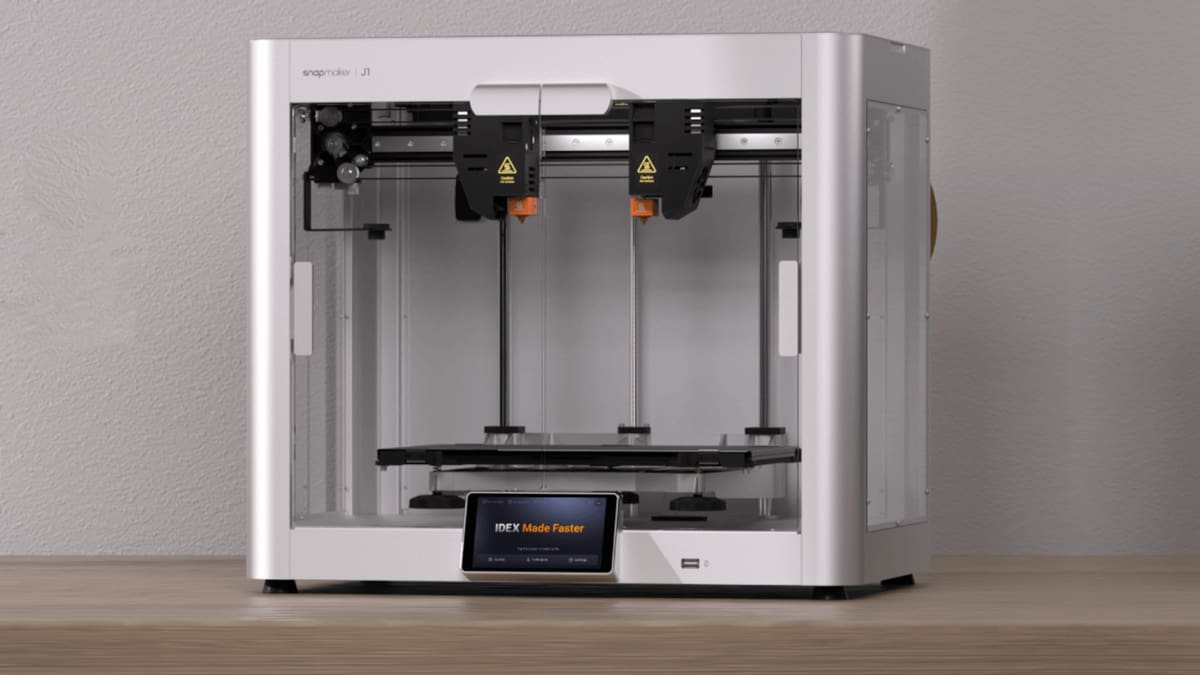
What’s Great
- Premium look and feel interacting with the printer
- Nicely-guided approach to calibration
- Productivity boosting IDEX print modes
There aren’t many independent dual extrusion (IDEX) 3D printers at a consumer-friendly price point. There are even fewer that pass muster. Of the systems we’ve tested, the Snapmaker J1s does. With a smidge of patience, this slick-looking tank of a 3D printer can attain reliable, consistent dual-extruder-pure performance for its $999 price tag.
The J1s excels at calibration, which is the one area you need an IDEX system to perform. Snapmaker’s system sidesteps a fully manual process, automating X- and Y-axis offsetting, and visually guides you through bed tramming on its gorgeous, 5-inch touchscreen display.
Its die-cast frame and stamped metal side panels, lid, and base all feel robust, and the heavy-duty motion system runs on linear rails, which lets the J1s chuck its two printheads around at what the Snapmaker says is up to 350 mm/s print speeds. Your mileage on this will depend on the materials and prints you run.
You get a 320 x 200 x 200 mm build area and a textured glass print bed to work with. The two print heads can be upgraded to different nozzle sizes or hardened-nozzle variants that expand the J1s’ compatibility with trickier technical materials that would quickly wear out a standard brass nozzle.
The J1s offers a thoroughly modern printing experience, with vibration compensation and linear advance calibrations addressing extrusion artifacts at speed. Being an IDEX means that the J1s has independent print heads that can operate in several productivity-boosting modes, provided you’re comfortable with the compromise of reducing your print volume per model. Filament wastage is minimized, too.
Spool placement on the back of the printer is annoying and the filament paths aren’t the best, sometimes needing you to intervene. Snapmaker’s Luban slicing software (which the J1s shares with the company’s 3-in-1 CNC and laser engraving-capable machines) does its job but offers fewer options for fine-tuning your print than many other popular slicers today.
Fortunately, Snapmaker recently announced a commitment to develop a new slicing solution based on OrcaSlicer. It’s currently in beta, but we expect it to offer a dramatic improvement for beginners and advanced users alike.
Toolchanger:
Original Prusa XL
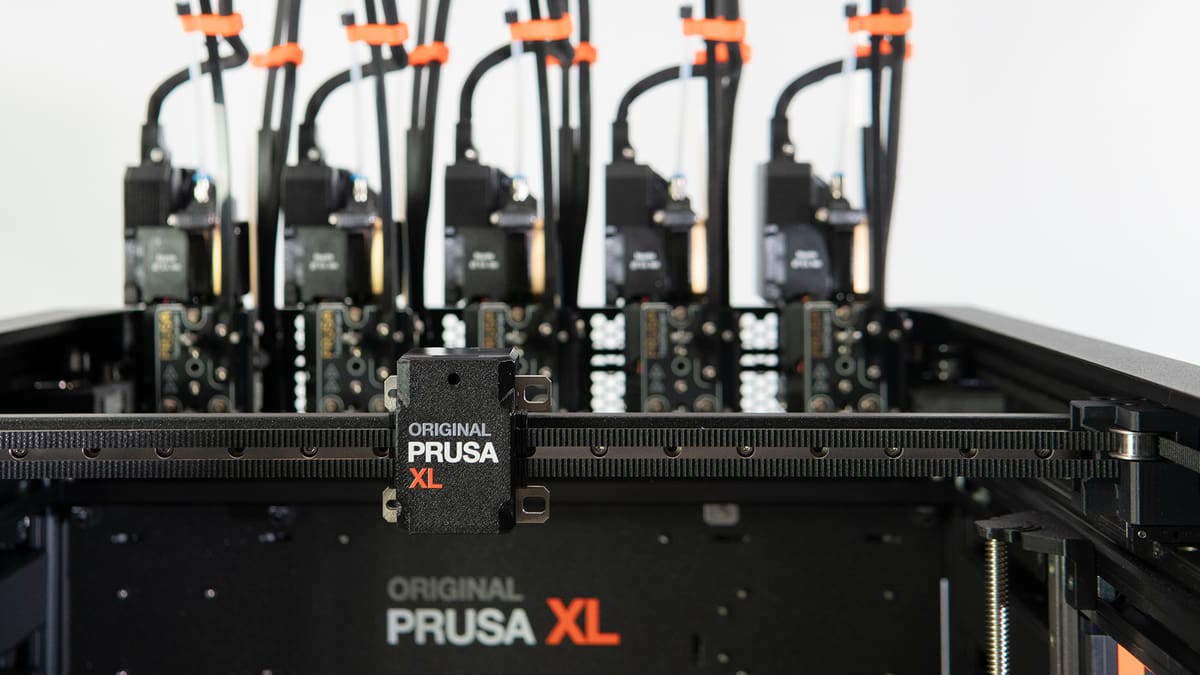
What’s Great
- Massive material flexibility
- Scales with your printing
- Quick, premium printing experience
Prusa Research’s 360 x 360 x 360 mm build-volumed XL does a solid job carving out a useful niche of the multi-material space that few other machines manage. Seen by the company as an expert machine for the material versatility it offers, we’re inclined to agree. The Prusa XL opens up an awful lot of possibilities when decked out in its full five-toolhead configuration. Such versatility comes at a price, though: ~$3,500 for a part-assembled kit you finish building yourself.
Being a toolchanger, it offers the advantage of completely independent print heads – meaning the materials do not share a nozzle and consequently are not at risk of clogging from differing viscosities, fillers, and temperatures. Each print head is capable of up to 290 °C and the heatbed of up to 120 °C, meaning reliable performance with tough filaments like Polycarbonate is also possible. Downtime between extrusions is minimized, too, since each active print head can sit at temperature ready for use.
The toolchange mechanism is quick and performs consistently, and seeing it sashay between materials without the need to withdraw the filament each time, as single-nozzle systems do, is impressive.
The XL’s heatbed is segmented into 16 tiles that can heat individually, depending on where and how much of the plate you are using. The Prusa XL effectively adapts to your printing, be it material or scale, and reduces waste where it can.
An enclosure accessory (sold separately, $649) improves the XL’s stability when printing higher-temperature technical materials, adding in-chamber lighting, humidity detection, and air filtration for a more office-friendly experience.
3-in-1:
Snapmaker Artisan
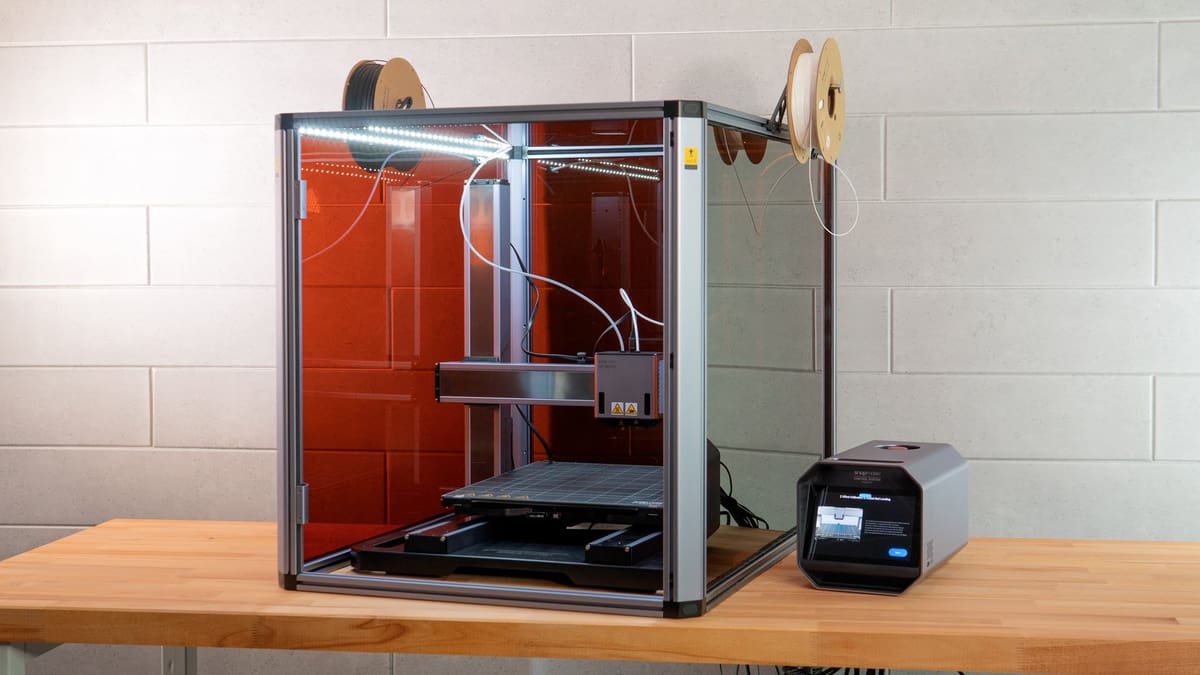
What’s Great
- Three creative tech tools in the footprint of one
- Feels premium
- Decent dual extrusion printing experience
There’s an unquestionable slickness to the machines Snapmaker makes. You get a high-quality fit and finish, backed up with glossy build guides and manuals to inspire your creativity. The Snapmaker Artisan is the latest in the company’s series of multifunctional machines. At ~$3,000, it’s a considerable ask, but between the device’s solidity and versatility with the multitude of creative processes you can tackle, it is quite unique.
Separating the Artisan from its predecessors is the perfected quick-swap mechanism, which makes changing modes a toolless, effortless procedure. The Artisan also benefits from bumps to speed and operating volume that make it faster and quieter than the Snapmaker 2.0.
More powerful laser and CNC modules come as standard, giving a slight spec bump on the 2.0, too. And there’s a nifty dual extrusion experience in the UltiMaker-esque print core system, letting you quickly combine different nozzle types in your work.
A massive, tinted enclosure comes as standard with the Artisan, to shield your eyes from the laser, and contain the mess of CNC engraving and cutting. There’s a vent for ducting smoke away from the setup, too, but note the enclosure has no floor – it is not airtight.
Impressively, the Artisan’s 400 x 400 mm print bed can heat up quickly, with user-selectable zones for quicker, more energy-efficient printing of smaller models.
If you expect to need to swap between 3D printing and laser engraving often and really put your machine through its paces, the Artisan is the comfortable choice. While it’s not necessarily better than a dedicated machine for each of the functions it offers, it does a competent enough job of combining the three.
Toy:
Toybox
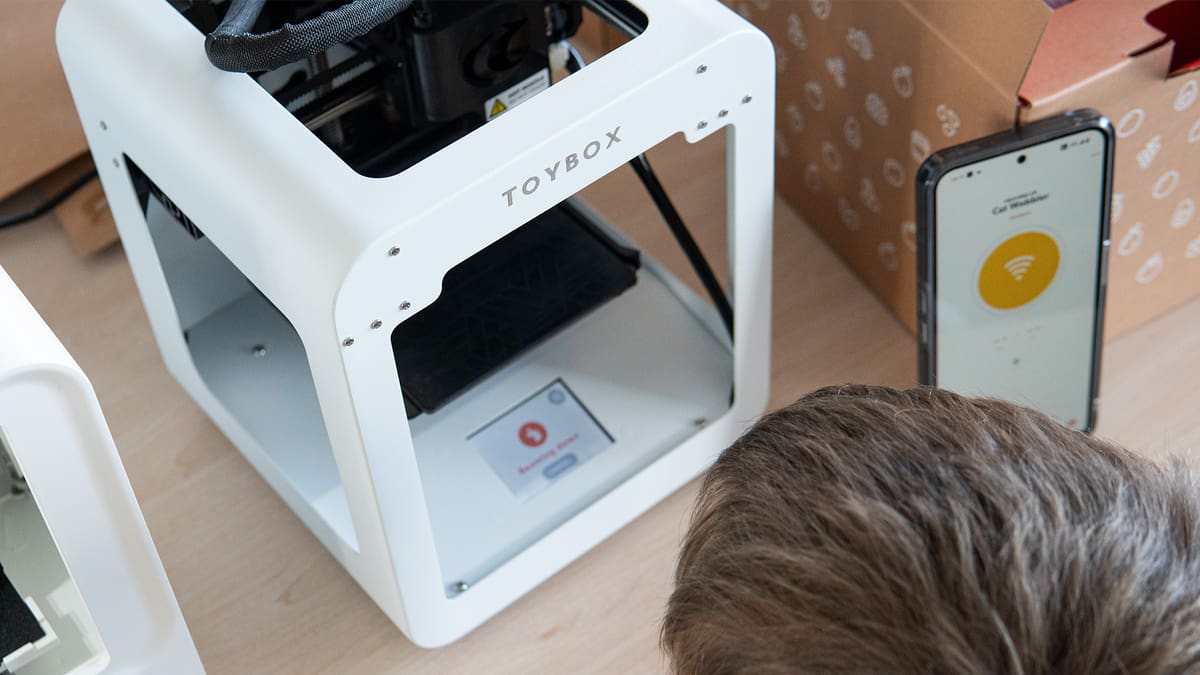
What’s Great
- Massive toy library to print
- Kid-friendly experience
- Snappy on-device UI and app-based control
Critics will point to its premium models and “plus” subscription as a negative, but much like the shows and movies your kids stream on the likes of Disney+ or Netflix, what Toybox offers isn’t so unfamiliar in this day and age. On the plus side, there are no ads, and the curation on offer means that not only is it possible to print everything you see, but it’s nearly impossible to mess up. The Toybox takes the effort of finding or making 3D printable toys, for the most part, out of your hands.
Buying the printer alone is enough to give you access to thousands of models and some basic in-app model creation from the get-go, but the 10,000+ library can be expanded through purchasable extras and a monthly subscription. There is plenty here to keep inquisitive young minds going.
Toybox’s greatest success is in cutting the clutter of the process of 3D printing and making every toy a tap away from physical reality. The print quality is not good. But having put all of the machines tested for our toy 3D printer guide in front of real, live, fidgety kids, they didn’t care. What mattered was finding a model in the library, and printing it out on the Toybox’s dinky print plate was fast. From our perspective, it was fast enough to keep pace with young kids’ short attention spans, and that’s what counts.
Under $1,000 (Resin):
Anycubic Photon Mono M7 Max

What’s Great
- Self-diagnostic smarts
- Heated vat as standard
- Time- and resin-saving features
With a budget ticking up to $1,000, there are two directions: big, or feature-rich. Previously, the UniFormation GKtwo was our pick for the wealth of neat little design touches that made using the printer a joy.
For $849, the Anycubic Photon Mono M7 Max does enough to pull us away by blending a large-format print volume, 298 x 164 x 300 mm, with the mod-cons of resin 3D printing in 2025. Its value lies in large-volume resin printing with plenty of success (or, rather, failure detection) systems to make it as simple as smaller-scale resin printing.
In testing, we found the system unobstructive (a rarity in large-format desktop resin printers) with the flip-hinge lid offering unrestricted access to the print chamber, and thoughtful inclusions like the integrated hook for hanging the print plate to allow resin runoff, to be genuinely useful.
A heated resin vat conditions your resin, increasing the chance of print success and, for longer, larger prints, an included resin pump can refill the vat mid-print for you. We’re not big fans of the resin pump since bottle changes can get messy – but it’s optional and you can just run the printer without it.
Overall the M7 Max is a refreshingly modern, smart, large-format resin 3d printer with a surprisingly low price tag for its size and feature set.
Under $500 (Resin):
Elegoo Saturn 4 16K
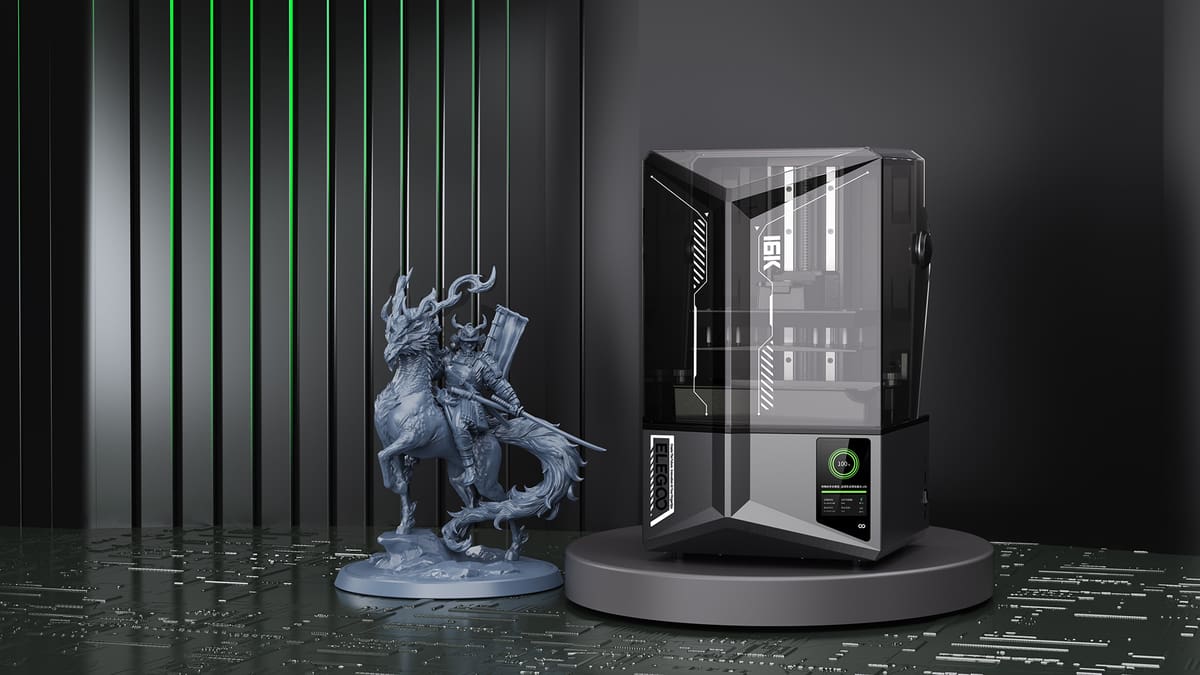
What’s Great
- Capable of fast, high-res printing
- Heated, tilting vat for fast, successful prints
- Well-implemented Wi-Fi connectivity
Our pick for a $500 budget resin 3D printer goes to the Elegoo Saturn 4 Ultra 16K, which sneaks under the line by a penny at $499.99. Going by the name alone you’d be forgiven for thinking it was just a resolution upgrade on the regular Saturn 4 Ultra, but there are a couple of killer distinctions that set the 16K apart.
For starters, the 16K introduces a heated resin vat that can condition your resin up to 30°C. This is essential for removing the environment from the equation of likely print success. Warm resin is happy resin.
And then there’s the better “AI” print monitoring camera that, this time, includes a light for 24/7 viewable time lapses and print monitoring. Sounds minor, but it’s a discernable step up in quality of life for this feature.
The build volume sits at 211 x 118 x 220 mm, shaving a couple of millimeters off the regular Saturn 4 Ultra. It’s a minor difference. Likewise, the jump up from a 12K to 16K LCD means the Saturn 4 Ultra 16K’s voxels, in the X/Y, shrink from 19×24 microns to 14×19 microns. That’s around a 20% improvement, but we’d caveat that 80% of something impossible to discern is still impossible to discern. They’re impressive numbers, but not the main attraction.
A rip-roaring mid-size flagship that offers virtually everything you could want on a modern resin 3D printer.
Under $300 (Resin):
Elegoo Saturn 3 Ultra
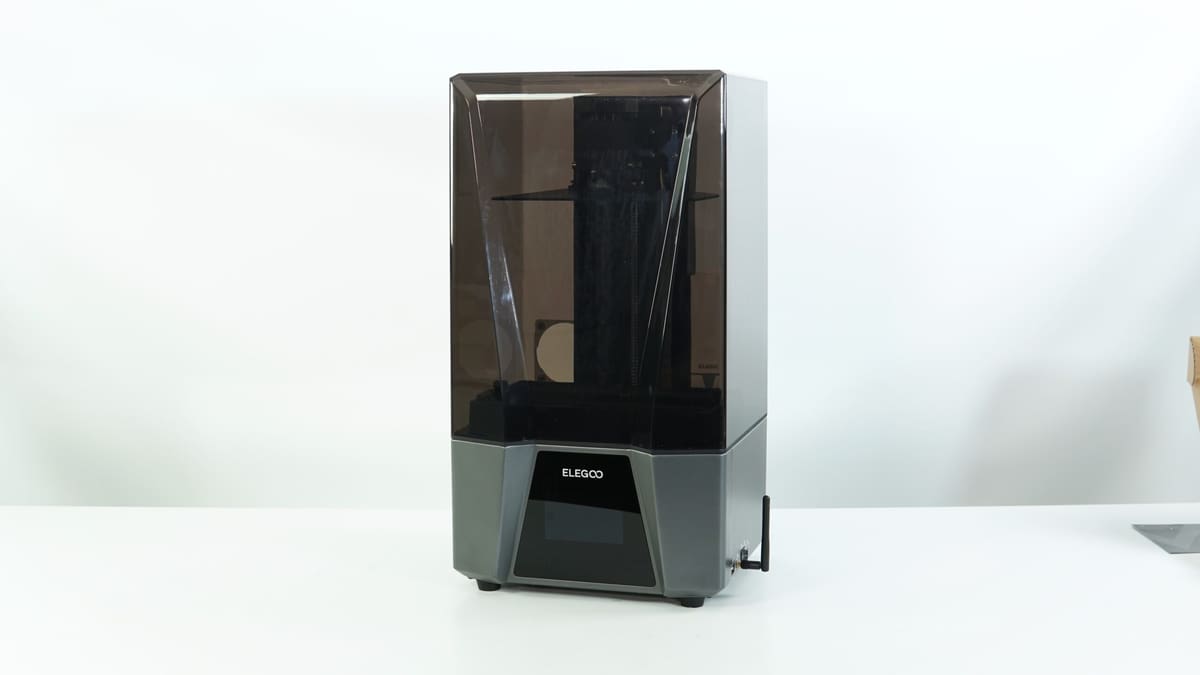
What’s Great
- Bleeding-edge resolution
- Useful Wi-Fi connectivity
- Top all-round performance
Elegoo’s pricing model is pretty wild, with last year’s flagship price tag dropping hard to make room for this year’s printer. It’s a big win for thrifty spenders, as it means that for $300, not much more than our sub-$200 pick, you can pick up a Saturn 3 Ultra, Elegoo’s top-spec model of last year, instead.
The biggest concession you’re making is that the Saturn 3 Ultra is a mid-size printer that would benefit from having a hinged, flip-style lid. It doesn’t have one, though, so you have to live with lifting its hefty grey bucket lid whenever you’re fishing out a print or topping up the resin.
In classic Elegoo fashion, the Saturn 3 Ultra is a workhorse, capable of finely detailed prints across its build area without the need for cajoling or praying to the machine gods. At least, that has been our experience using it in the lab. You get ~219 x 123 x 260 mm of build volume to work with.
There’s a ventilation port on the back of the printer, for those running a hose to a window or extractor. Likewise, you can plug in a replaceable USB-powered air filter, which will quietly run to reduce the smell coming from the resin.
The Saturn 3 Ultra can achieve up to 150 mm/s print speeds thanks to its use of ACF film in the resin vat. Some claim this film isn’t the best and can result in artifacts on your prints. In our experience, nuh-uh. But, if it does, the film is an easily swappable consumable – other films, including newer formulations of ACF, which would maintain the high print speed, are available.
Under $200 (Resin):
Elegoo Mars 5
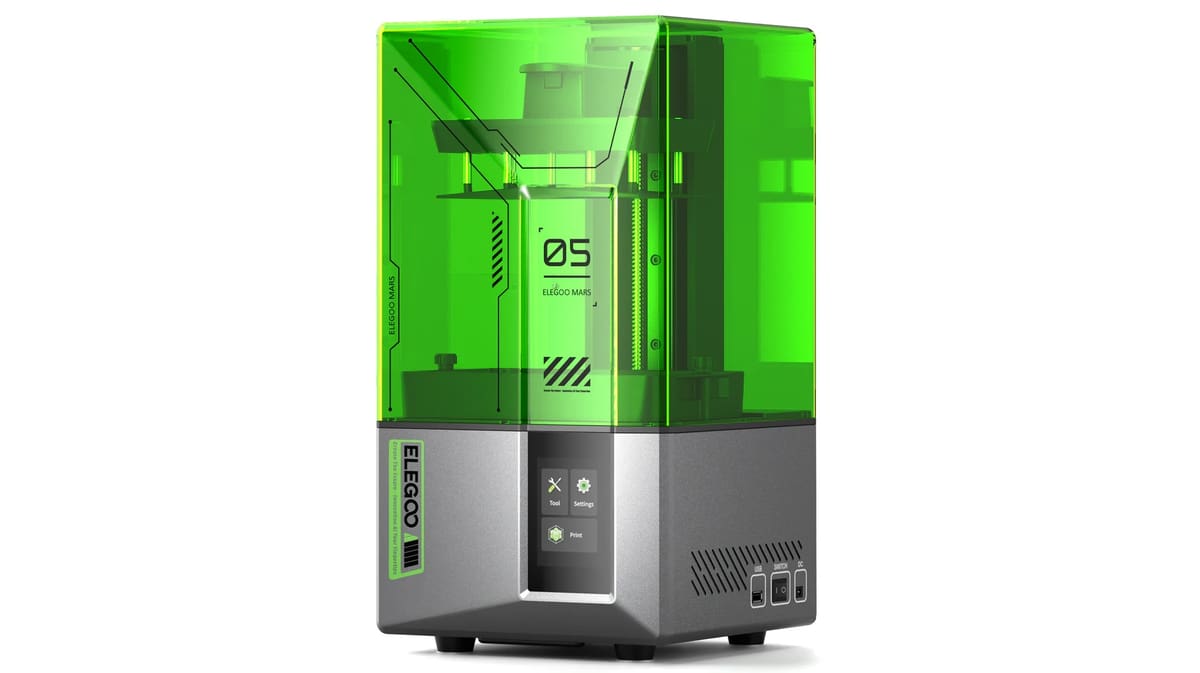
What’s Great
- Resin level & print failure smarts
- Useful Wi-Fi connectivity
- Self-leveling
The Elegoo Mars 5 is the latest of Elegoo’s “cheap and cheerful” base Mars model of 3D printer, priced at ~$180. While it won’t print as fast as the pricier Mars 5 Ultra (primarily because it lacks a vat tilting mechanism), it does offer a suite of sensors to help you get through your prints without much hassle.
The Mars 5 features Elegoo’s new style of print plate, which sits on springloaded standoffs – this is, ostensibly, the plate leveling mechanism, allowing you to unbox and start printing without the need for a pre-print level, minus the resin and with the printer in a clean state. This is a key feature for beginners, reducing the frustrations in preparation of a print.
Unusually for a sub-$200 resin 3D printer, the Mars 5 features a full systems self-check, letting you know if the printer is in good operable condition.
Size-wise, you get ~143 x 89 x 150 mm of build volume to work with, which puts the Mars 5 firmly in “small” resin 3D printer territory.
Overheat protection and the option to enhance the printer further with add-ons that plug into the printer’s in-chamber USB port, such as a heater (useful for ensuring the resin is in a good state for printing) or an air filter, to help reduce the smell from the resin, all of which let you customize the setup to your situation.
Overall, the Mars 5 is a compact, smart 3D printer that offers great value for money.
Ecosystem (Resin):
HeyGears Ultracraft Reflex RS Combo
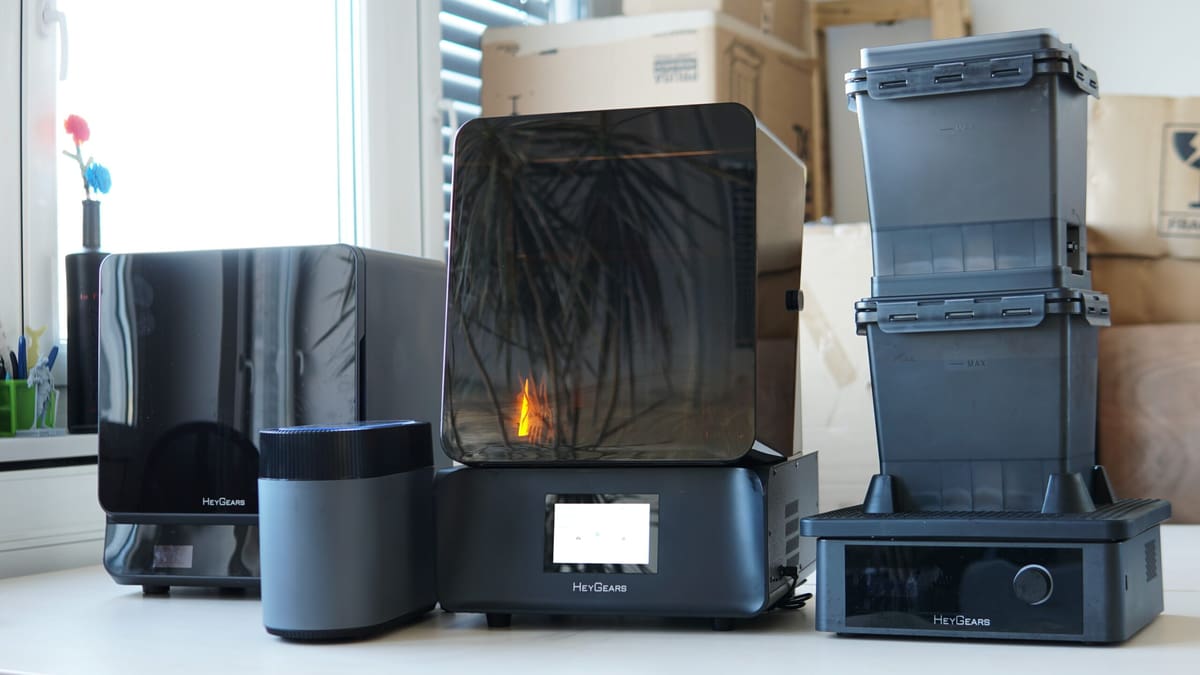
What’s Great
- One-click printing carries through wash and cure post-processing steps, too
- Pulsing release module lets you cut back on supports
- Exceptional print quality for zero effort
Ordinarily, a printer like the HeyGears Ultracraft Reflex RS would be prime under-$1,000 fodder in our buyer’s guide, but that wouldn’t accurately capture how pinpoint perfect the complete ecosystem is for this machine which, bought together, balloons the price up to $2,000+.
Most, if not all, resin 3D printer manufacturers offer peripherals, wash stations, cure boxes, and the like for their printers. HeyGears’ offering goes beyond such blunt tools to tread on the toes of the likes of Formlabs, for a fraction of the price.
It is a walled garden – a touchy subject in 3D printing, true – meaning material compatibility is limited to HeyGears’ short (but soon growing) list of resins, but within that limitation is the elimination of doubt that your print will work.
The software, Blueprint, simplifies print setup and links all of the Reflex RS 3D printer, Wash Station, and Curing Oven, letting you walk a job from printer to each step of post-processing with the stations knowing what the job is and tailoring the wash and cure cycles to the specific print.
The Reflex RS printer offers a pleasant user experience with a hinged lid and simple-to-attach print plate, and the nifty status lighting just looks cool. You get a build volume of 222 x 122 x 230 mm to work with, which puts the Reflex RS squarely in the medium-format size class.
It’s a comprehensive resin printing and post-processing solution, made even better if you throw in the Pulsing Release module and its accompanying heated resin vat. This device sits next to the printer and pumps air through channels in the heated vat to reduce the peel force in your prints. Consequently, you need fewer supports and can achieve shearer overhangs, saving material and time. It’s a thoughtful addon that to our knowledge, no other printer offers.
Small (Resin):
Anycubic Photo Mono 4 Ultra
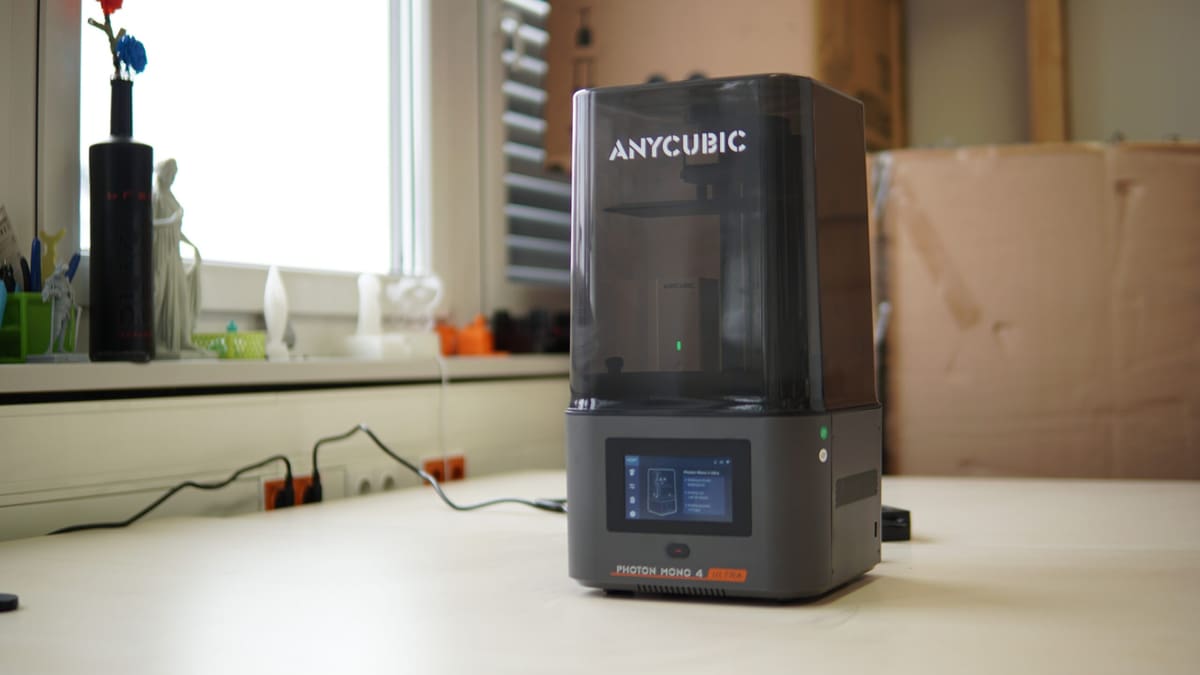
What’s Great
- Packed full of fail-safes to save you material and time
- Wi-Fi and app connectivity
- Capable of quick printing
We were big fans of the Anycubic Photon Mono 2 for its low-cost low-frills approach to resin 3D printing. The Anycubic Photon Mono 4 Ultra, $259, is the ultimate glow-up.
Anycubic reserves the odd numbers for its “main” M-series. We don’t know why. Regardless, the Mono 4 Ultra earns its name well and is remarkably feature-packed for its stature and price. It is, in many ways, a mini flagship 3D printer.
Beneath its lightweight bucket lid lies a ~153 x 87 x 165 mm build volume – sufficient for minis, terrain, jewelry, and the gamut of typical resin 3d prints. There’s space for an in-chamber air filter (sold separately), while a 10K 7-inch LCD provides the framework for 17 x 17-micron resolution in the X- and Y- axes.
The Mono 4 Ultra’s UI borrows from the M7 series – an evolution of the one the company introduced with the Mono M5S back in 2023 – and presents a marvelously clean and logical array of controls and options for using the 3D printer.
A guided setup wizard walks you through the first power on of the machine, with self-checks taking over from there. That’s right, this mini Mono knows thyself and can tell you when something is wrong. “Wrong” in this case can mean insufficient resin to complete the job at hand, and prints failing to adhere and sitting stuck in the resin vat (zero force at layer change). It’s a smart cookie and a godsend for saving time and money on wasted resin when things don’t quite work out.
ACF film comes as standard in the resin vat, allowing print speeds (using Anycubic’s high-speed resin – other high-speed resins are available) in the region of 120 mm/h, although as is always the case, your mileage will vary based on the resin you use and printing parameters for the job.
Cloud functionality is there if you want it, pulling models and slicing in the cloud per Anycubic’s MakerOnline repository, as is printer monitoring and control. You can choose not to use this and simply ferry prints via USB.
Anycubic tells us a LAN mode is coming this year, which is very exciting and would make for a great security improvement over the company’s historically shaky past on this subject.
Mid-Size (Resin):
Elegoo Saturn 4 Ultra
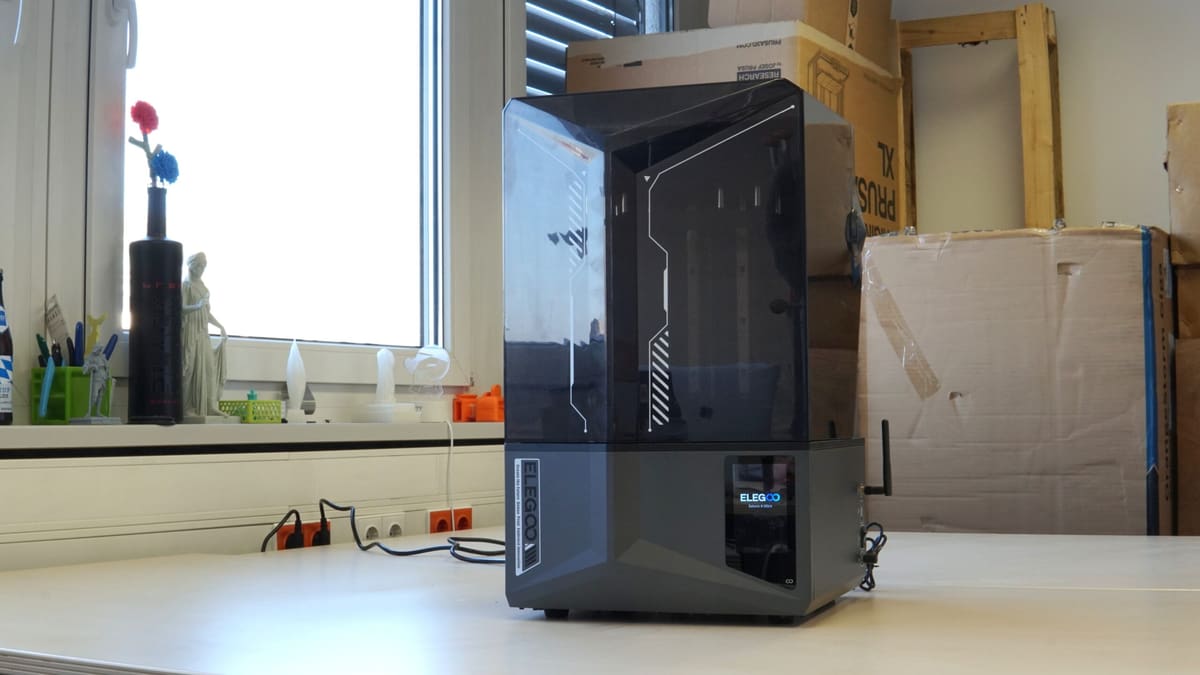
What’s Great
- Capable of fast, high-res printing
- Resin level & print failure smarts
- Well-implemented Wi-Fi connectivity
The Elegoo Saturn 4 Ultra is a mid-size resin 3D printer, which is just about where its being “mid” ends. A high-resolution LCD sits atop Elegoo’s new-for-this-generation vat tilt mechanism, which the company says reduces peel force at layer change and overall layer time.
The printer drips quality, from the reassuring tilting lid to the self-checking and print monitoring systems. It’s internet-connected and is, natively and fully operable with all popular third-party slicers, plus Elegoo’s new Satelite slicer, which promises a complete, beginner-friendly experience that features all the tools you need. We’ve not tested Satelite yet, so can’t speak to that aspect, but the workflow using most popular slicers is functionally effortless.
In testing, we found the Saturn 4 Ultra met every task we threw at it with no memorable hiccups. You get a ~218 x 122 x 220 mm build volume, and Elegoo benchmarks the printer as capable of printing up to 150 mm/h. This number will depend on the resin you use and its idiosyncrasies for curing and timing.
At $399, the Saturn 4 Ultra is tremendous value. Elegoo has just launched a slightly higher resolution version, the Saturn 4 Ultra 16K ($499), which ekes out an impossible-to-discern bump in print quality and adds features like a heated resin vat and improved camera setup.
On a complete tangent, there’s a fun unintentional aspect to the Saturn 4 Ultra that fits its space-themed naming, too: the sound the tilt vat makes on booting up the printer. As it performs its self-checks, it’s a dead ringer for the “Wooooh” of air escaping from human Bender (Futurama – season 4, episode 3). You’re welcome.
Large-Format (Resin):
Anycubic Photon Mono M7 Max

What’s Great
- Self-diagnostic smarts
- Heated vat as standard
- Time- and resin-saving features
Anycubic’s new M7 series of resin 3D printers are a comprehensively decent bunch, making massive strides on the mish-mash of M3 and M5 printers that came before.
Nowhere is this more exemplified than in the M7 Max, which boasts a sweeping 298 x 164 x 300 mm print volume. While it’s not the largest build area in the desktop space (our previous pick, the Phrozen Sonic Mega 8KS, topped it slightly in all directions) the M7 Max offers many features to help ensure the success of the massive prints you’ll be pulling off the print plate. That, and it’s attractively priced at $849.
In addition to the myriad force sensors to detect the presence of enough resin, foreign objects, and successful peel separation from the resin vat (all common across the M7 series), the M7 Max has a heated resin vat to ensure the appropriate printing temperature for the resin – an important catalyst in resin 3D print success.
Helping to speed your prints along is Anycubic’s “Intelligent Release 2.0” algorithm, which adjusts the layer lift height during the print, potentially saving time across the duration of what will, inevitably, be a several-hour job.
In the time we’ve had it running in the All3DP lab, small design touches have endeared this printer to us. For one, a hinged flip lid is, in our view, essential on larger machines like this; particularly if, like us, you run them in an enclosure with air filtration where space may be at a premium. There’s also a hook to hang the build plate post job to let resin drip back into the vat.
As is common across Anycubic’s non-budget 3D printers, cloud operability and connectivity are present, letting you keep tabs on your printer’s status, maintenance schedule, print jobs plus the sundry model-related functions Anycubic offers via its MakerOnline model repository.
The company informs us that a LAN mode is coming soon, which will allow you to use the remote functionality locally, disconnected from the internet. Given recent controversies, this will be a very welcome thing that only improves Anycubic’s hardware in our view.
Beginners (Resin):
Elegoo Mars 5

What’s Great
- Resin level & print failure smarts
- Well-implemented Wi-Fi connectivity
- Self-leveling
It’s usually pretty solid advice for beginner machines to go with something inexpensive and simple. That is very much the case with resin 3D printing.
Many of the arguments we made for the Mars 5 being a great 3D printer under $200 carry over here. For ~$180, you get a resin 3D printer that’s effortless to set up and smart enough to tell you when something isn’t right for the printer or print, such as insufficient resin in the vat, or subsystems falling outside of acceptable performance. The build volume runs to ~143 x 89 x 150 mm, in the same ballpark as our best small resin 3D printer pick, the Anycubic Photon Mono 4 Ultra.
Elegoo set a standard for budget resin 3D printers many years ago and in 2025 it continues to do so. It’s not a revolutionary 3D printer, but it does enough to offer the better ideas of today’s flagship models in a punchy, sub-$200 package that’s uncomplicated to set up and start using.
What's Changed?
To help you keep track of past recommendations and structural changes to what we’re testing, here’s a changelog of what’s happened to this article in the last 12 months:
Update – February XX, 2025: A whole new slate of resin 3D printers to suit all budgets and capabilities refreshes half of this guide, alongside new entries in the Prusa Core One and Elegoo Centauri Carbon: two excellent enclosed 3D printers at opposite ends of the budget spectrum.
Update – September 04, 2024: Sweeping changes to our dual-extrusion guide (which now covers multi-extrusion tech better), plus updates to the best budget 3D printers and large format 3D printers, mean seven new recommendations in this update.
Update – March 14, 2024: This update brings the guide up to speed with recent changes to our budget, dual-extrusion, and large-format resin 3D printer guides.
How We Test
If there’s one thing that testing a lot of 3D printers has taught us, it’s that maintaining a broad benchmarking scheme for 3D printers is impractical for getting a sense of what a 3D printer is like to use and live with. Holding a sub-$200 self-assembled printer for hobbyists to the standard of a $6,000 production machine designed to handle engineering-grade materials won’t tell you that the former is a breeze to set up and the latter a tangled web of firmware updates, buggy systems, and unreliable performance.
We want our reviews and buyer’s guides to cut straight to the chase. What is it like to use a printer? What are the defining features like? What didn’t we like? And, more importantly, is it worth the money? We don’t want to get bogged down benchmarking numbers out of context or hung up on issues affected by more variables than we can control.
Who Are We Testing For?
Our buyer’s guides and reviews take the intended end user of a 3D printer into consideration. We imagine what they’re likely to do with it and focus the testing on challenging this. If we have a large-volume printer, for example, we’ll be printing – surprise, surprise – large prints, making use of the entire bed, and checking the performance at the limits of Z-height.
Other points of consideration for what makes the best 3D printer include ease of use, supporting software, and repair options. If something goes wrong, how easy is it to fix the machine? Does the documentation or customer service provide adequate information?
We strive to answer all these questions and more in our quest to find the best 3D printer for you.
Why Should You Trust Us?
Trust is important to All3DP, so our product testing policy is strict. When sourcing test units from a manufacturer, we do so under a zero guarantees policy. We make no guarantee of coverage in exchange for the printer, and the first time a manufacturer sees what we think is when we publish the content.
If a manufacturer doesn’t reclaim the unit after testing is complete, it is donated to a local cause or goes into deep storage for responsible disposal later. We occasionally buy machines for testing, too. In such cases, machines purchased by All3DP either remain in the office for team usage or are donated or disposed of in the manner described above.
Manufacturers or benefactors donating units for review do not influence the outcome or content of the reviews we produce. To the best of our ability, we will investigate abnormal issues with the manufacturer to glean better context or get insight into their awareness of the problem. But we make no excuses for poor design or bad QA.
How We Monetize Our Content
One method we monetize our content at no additional cost to the reader is through affiliate product links. If you click on a shopping link featured in our buyer’s guides and reviews, we may receive a small commission from the store if make a purchase. This is at no additional cost to you. For more meaty content policy details, we cover it all in the advertising and commercial activities section of our terms of use.
Which 3D Printer is Best for Me?
For most readers, our top recommended 3D printers are your best bet in a given category.
But, facing the fact that there is no one-size-fits-all solution to home 3D printing, we’re here to help. Here are some pointers to orient you in this terminologically dense but wonderful world. (A word on terminology, we have a handy glossary of terms to know at to bottom of this article.)
Beginner’s printers
Many 3D printers pitched for “beginners” or children go to such lengths to baby the user that they quickly become claustrophobic experiences. You will encounter more limitations than possibilities as your experience grows. If you aren’t satisfied with a “beginner” 3D printer’s features, we’d recommend a budget pick instead. You’ll save a little money, and the opportunity to learn by doing is far greater. And if something goes wrong, there are giant tribes online for each printer that have already asked and answered every question under the sun.
Follow the crowd
While the general quality of budget 3D printers has dramatically improved in recent years, quality control is often lacking. While manufacturers with large user bases are adapting to meet the demands of their newfound fans, including better customer support, there are usually better wells of knowledge to be found in the owners themselves, who contribute to the vast forum knowledge bases for some 3D printers.
Reviews matter
We have zero obligation to manufacturers to sugarcoat what we find, and the first time they read it is when you do too. That’s why you can trust our reviews. We don’t pander to anyone, and our experience with the printer is what you read on the page.
If you can’t find any information about a printer you’d like to know more about, let us know at editors@all3dp.com.
Understand the costs
A 3D printer for the home is rarely ever a one-and-done investment. Besides the continual purchase of materials, maintenance costs on perishable printer parts can stack up – think nozzles on an FDM printer or FEP film on an MSLA machine. Of course, parts can wear down or break, too, meaning sourcing replacement parts is a sensible consideration if you plan to print long-term. Printers with roots in the RepRap movement and open-source designs will be easiest to source parts for, with off-the-shelf components part and parcel of the design ethos behind them. Enclosed-design printers aimed at beginners may offer the gentlest introduction to printing, but your options to source spare parts will often be limited to the manufacturer. That’s if you can even get to and diagnose the problem.
Know why you want to 3D print
The thrill of a new hobby will only sustain you so far. Being the desktopification of an otherwise complicated manufacturing process, expect to encounter, sooner or later, problems with a home 3D printer – even the occasional show-stopping issue. Having an end goal in mind for your printing gives you purpose and a reason to learn the solutions to the problems. Printing simply because it looks cool will result in a small mountain of useless doodads and, eventually, disinterest at the hands of cost, frustration, and the buildup of useless plastic trash.
When you do know, pick a printer that will make it easier
Most home 3D printers are single extrusion fused deposition modeling machines, meaning a single printable material extruded through a single nozzle. Versatile enough for many applications through material compatibility, they’re safe machines to start with. But if you know you need to print objects with challenging geometries or semi-enclosed volumes, a dual extrusion printer would make your printing far easier. Likewise, single objects that need to have different material properties will only be achievable with dual extrusion. A resin printer will be the way to go for high-detail miniatures. Understand the technologies to find a printer that best suits your needs.
Pick a printer appropriate for your space
While the size of FDM 3D printers can vary greatly, the spillover is small. You’ll get some emissions from the filament melting, cloying the air, making it inadvisable to spend prolonged periods nearby. Generally speaking, the cleanup is minor and relatively easy to contain, depending on the models you print.
Resin 3D printing, however, is dramatically different and has unique demands that should make you think twice before investing. To varying degrees, the resin is smelly and toxic to you and the environment. It requires dedicated cleanup stations and personal protective equipment. You typically need 95 %+ isopropanol to clean prints and dissolve uncured resin from surfaces.
All printers should be operated in well-ventilated spaces, but this applies doubly to resin 3D printers.
Kickstarter – It’s complicated
While many excellent 3D printers have gotten their big break on Kickstarter, there’s the unavoidable issue that the platform is not a store. You are not buying a printer when you commit money to a campaign on Kickstarter; you are backing a vision. It’s putting money into the pot to help a company or person trying to achieve something.
You get nothing in return if a project is grossly mishandled and the money disappears. Often what you do get is the beta version of the product. You are paying for early access and all the wrinkles across all stages of the product that come with it.
We’re seeing more big-name companies turning to Kickstarter than ever to launch their products – it’s a safe way for them to gauge demand and drum up some interest against the pressure of a ticking countdown. Despite many companies being capable of outright launching products, they go cap-in-hand to enthusiasts with the promise of shiny new tech. Don’t be that user unless you absolutely must be the first to use a product and have money you can afford to lose.
We don’t think it’s worth the risk, but in the interest of cool new tech, report on new campaigns with our news coverage. You will never see a Kickstarter 3D printer in our buyer’s guides unless it has completed its campaign and the printer is widely available at retail, with all the protections that come with buying from a store.
Best Professional 3D Printers
But where’s the UltiMaker? Or Formlabs? What about Raise3D? Desktop Metal?
In the past, we’d list the best professional 3D printers alongside what we consider consumer or hobby-oriented machines (the printers we mainly focus on). An apples and oranges comparison, we know.
With this in mind, we created All3DP Pro, a wing of our content exclusively covering the professional applications of 3D printing and additive manufacturing solutions. Here’s a selection of articles covering the best 3D printers for professional use to get you started.
- Top 6 Professional 3D Printers Under $10,000
- The Best 3D Printers for Small Businesses in 2025
- The Best Metal 3D Printers in 2025
- Best Desktop-Size Carbon Fiber 3D Printers: Our 10 Picks
- The Best Carbon Fiber 3D Printers for Industrial Use
- SLS 3D Printer Buyer's Guide 2025
- The Best Independent Dual Extruder (IDEX) 3D Printers
- The Best Ceramic / Pottery 3D Printers
- The Best Dental 3D Printers 2025
- PEEK 3D Printer Guide & All You Need to Know
Glossary of Terms
Choosing the best 3D printer is tricky, not least because the terminology surrounding 3D printing is dense. Here are some need-to-know terms, their explanations, and useful links to help you on your way to 3D printing mastery.
FDM: Fused deposition modeling, otherwise known as FDM, is a 3D printing process that extrudes heated thermoplastic material through a moving nozzle to build an object layer by layer. FDM is a trademarked term, which led to the RepRap open-source movement to coin the alternative phrase “fused filament fabrication” (FFF), but the two are interchangeable.
Filament: Filament is the base material used to 3D print objects via FDM. The filament is typically a solid thermoplastic fed to a print head, heated to its melting point, and extruded through a small nozzle. Filament is commonly available in spools of either 1.75 mm, 2.85 mm, or 3 mm diameter widths – dimensions that dictate the printers that can use them.
G-Code: G-code is the machine language used to instruct computerized tools such as 3D printers. Giving coordinates and instructions for tool heads and other non-movement functions, it is almost exclusively generated by slicing software. It comprises a library of commands to control specific actions like motion, speed, rotation, depth, and other related switches and sensors used in a machine’s operation. You can get to grips with G-code in no time with our guide to G-code commands.
Heated bed: This is a build plate that is heated so that the few layers of extruded plastic are prevented from cooling too quickly and then warping. A heated bed is essential for working with ABS or PETG materials but not so much with PLA.
Hot end: This is the cluster of components that heat and melt the plastic for deposition through the nozzle.
Extruder: Used by some to describe the entire system of parts that pushes and melts filament, extruder can also refer specifically to the motor and accompanying gears that grip the filament, feeding it to the hot end. How the extruder is arranged can affect the printer and its capabilities. There are two common arrangements: Bowden and direct. It’s a messy subject with overlapping terms and technical explanations; our guide to 3D printer extruders gives you all the knowledge to make sense of it.
Bowden: A style of extruder that sees the extruder motor positioned away from the hot end – typically the structural frame of the printer or on one end of the X-axis gantry. So-called for the Bowden cable and its action of allowing a wire to move freely within tightly constraining tubing, the Bowden extruder feeds filament through a PTFE tube directly into the hot end.
Direct Extruder: The other commonly seen extruder type, a direct extruder sees the extruder motor and associated feeding mechanism mounted directly to the hot end, with barely any distance between the feed and the melt zone of the hot end.
Dual Extrusion: Some 3D printers carry two extruders/hot ends, allowing them to incorporate multiple colors or materials into the same print job. While the obvious appeal comes from the possibility for decorative two-tone prints, the real benefit of dual extrusion systems is combining different materials, such as dissolvable support material, to enable the printing of otherwise impossible geometries. It’s a deep topic worth exploring more in our guide to all you need to know about dual extrusion.
PLA: Polylactic Acid, otherwise known as PLA, is a thermoplastic commonly used as a material for printing with FDM 3D printers. It’s easy to work with and is available in many colors and finishes. PLA is somewhat brittle – don’t expect to print strong items with it – but it remains popular for decorative printing thanks to its low cost. You can learn more about PLA in our guide dedicated to the topic.
SLA: Stereolithography is a 3D printing technology that falls under the broader process of vat photopolymerization. The term is often (incorrectly) used to describe all methods of vat polymerization – really, it’s a particular technology that uses a directed laser beam to trace layers into a vat of liquid photopolymer resin. Alongside SLA, other technologies are considered vat polymerization.
Resin: The material used in desktop SLA, DLP, and LCD (MSLA) 3D printers. A blend of chemicals that includes a photoinitiator, resin solidifies under ultraviolet light. Highly toxic and difficult to clean up after a spill, care, attention, and personal protective equipment are musts when working with resin. It is an unpleasant material, and wastage must be disposed of in accordance with local laws. Despite all the warnings, it’s the only way to go for intricate detail.
LCD 3D Printer: A common term for resin 3D printers that use an LCD as a layer mask over UV light. The de facto standard in inexpensive resin 3D printers, the technology is cheap and widely used. The LCD panels are consumable, though, with monochrome LCDs typically having lifespans in the low 1,000s of hours.
MSLA: Mask stereolithography (MSLA) is a term coined by Structo but popularized by Prusa Research. It refers to, basically, the LCD 3D printer as described above.
Micron: One-thousandth of a millimeter. This unit of measurement is commonly used in 3D printing as a value to indicate accuracy, resolution, or surface finish.
Slicer: 3D printing works by building an object layer by layer. A slicer is a program that divides a 3D model into flat layers and generates the machine code for the printer to trace out said layers. The output of a slicer for FDM 3D printers is typically G-code, which gives instructions and coordinates for the printer to execute. Our deep dive explaining what exactly a slicer is gives good foundational knowledge. Many popular slicers are free and open source. Others are proprietary and machine-specific. It’s an essential tool for successful 3D printing.
STL: STL is the most popular file format for 3D printing. Developed by 3D Systems in the ’80s, the STL file type only contains the surface geometry of a 3D object. Despite industry efforts to move onto more efficient and data-rich formats such as 3mf, STL endures and is the most commonly found 3D model file type on popular 3D model file repositories. We explain in more detail in our guide to what exactly STL is.
Open Source: The term given to a product, typically software, but also applicable to hardware that is freely open for others to modify and redistribute according to their needs. In 3D printing, this is often in the spirit that individuals are free to modify, improve, and share changes to the source material for others to test, iterate, and reciprocate. Open source licenses govern the fair and correct usage of open source works, giving terms and conditions that ensure the freedom of access to the creation and any derivatives.
RepRap: A project started in 2005 by Dr. Adrian Bowyer, a mechanical engineering lecturer at the University of Bath. Created to develop a replicating rapid prototype, a low-cost machine capable of printing replacement parts for itself or other new machines. The vast majority of desktop 3D printers stem from the work laid down by the RepRap project. We have a fascinating alternative RepRap Wiki page on the topic if you want to dig deeper.
License: The text of "Best 3D Printers of 2025: Top Picks in 26 Categories" by All3DP is licensed under a Creative Commons Attribution 4.0 International License.
CERTAIN CONTENT THAT APPEARS ON THIS SITE COMES FROM AMAZON. THIS CONTENT IS PROVIDED ‘AS IS’ AND IS SUBJECT TO CHANGE OR REMOVAL AT ANY TIME.

 Stay Informed, Save Big, Make More
Stay Informed, Save Big, Make More

